Prices have been brought up to date, and are for stamps in 'average' condition. The currency is now selectable, the default is British Currency (£). I have revised Hiscocks' original listing, though leaving references to the original designations. The new designations have 'RH' numbers (Revised Hiscocks) to avoid confusion. Setup |
Steve Hiscocks wrote:
The company was set up on 24 July 1860 with the aim of establishing a low uniform rate system analogous to that of the penny post. In fact their
initial charge of 1s for less than 20 words regardless of distance was too low and they adopted in 1865 a graduated scale of about 2/3 the rates of the
opposition. The company was purchased by the Postmaster-General in 1869 by which time it was one of the two principle UK inland operators
along with the Electric Telegraph Company. Large numbers of the stamps were used and the company accounts for 1864 showed that unused
stamps to the value of over £2,000 were at that time in the hands of the public. The stamps are thus relatively common. The second issue are also found
overprinted 'INT' in black. This is apparently short for 'INTEREST' and these stamps were issued to shareholders in lieu of a cash dividend at a time
(early 1865?) when the company was financially particularly hard pressed. All stamps with the possible exception of one) were produced by De la Rue
and have black printed control numbers. The perforation 15½ x 15, is that of the UK postage stamps of similar size and date by De la Rue.
My notes:
The yellow highlighted section is misleading. The control numbers for the values having the 'INT' overprint alternates between normal
and overprinted showing 9 or 10 periods of use. There were two dividends each year, so that represents
about a 5 year period of being 'financially particularly hard pressed'.
The stamps were unusual in that they were recess printed by De La Rue (except H15) and comb perforated by Somerset House.
This makes them higher quality than most of the other private telegraph companies, a possible exception being
The South Eastern Railway engraved by Whiting, but let down by most of the perforating.
They were also unique in using control numbers, but having no place in the design reserved for them.
The early used ones did not use control numbers, so they had not been planned for.
| Shortcuts to different sections | |||||||||||
| Vertical | Horizontal | Control sizes | I N T | Blued paper ? | Calculator | Redrawn 1/- | List by Controls | Blocks | Cancels | Shades | Stationery |
The first stamps (late 1861) were in a vertical format with values of 3d brown-ochre, 6d rose and 1s lilac.
Initially they were issued and used without control numbers.
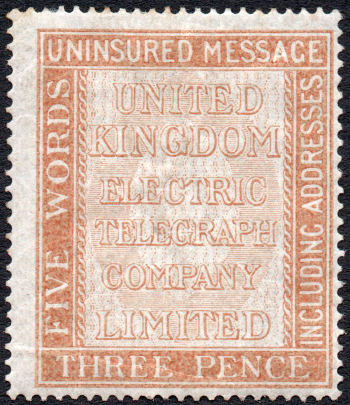 |
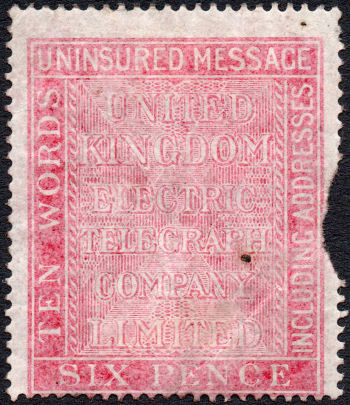 |
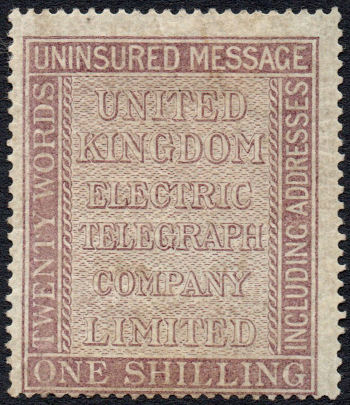 |
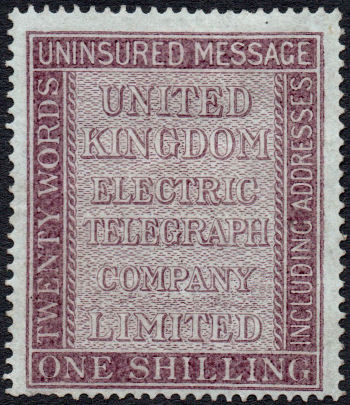 |
| 3d - RH1b (no control) | 6d - RH2a (no control) | 1s - RH3a (no control) | 1s blued - RH4a (no control) |
| Images courtesy of Steve Lawrie. | |||
Die proofs of the Shilling value were ready by 9th September 1861, ready for the first delivery 12th December 1861.
A selection of Proofs, courtesy of Steve Lawrie.
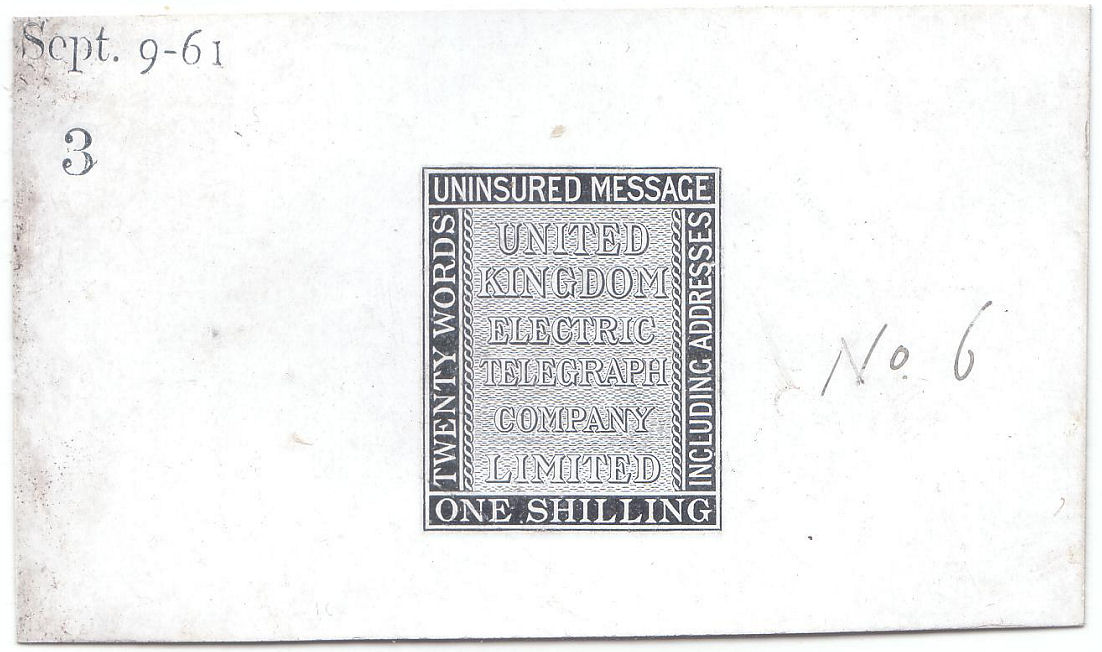
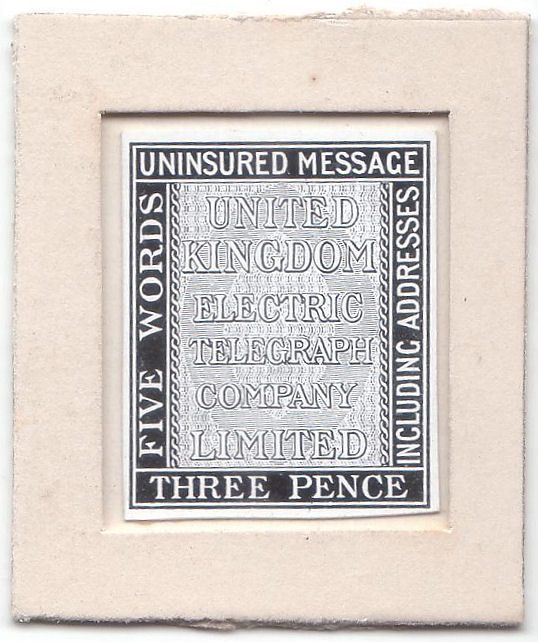
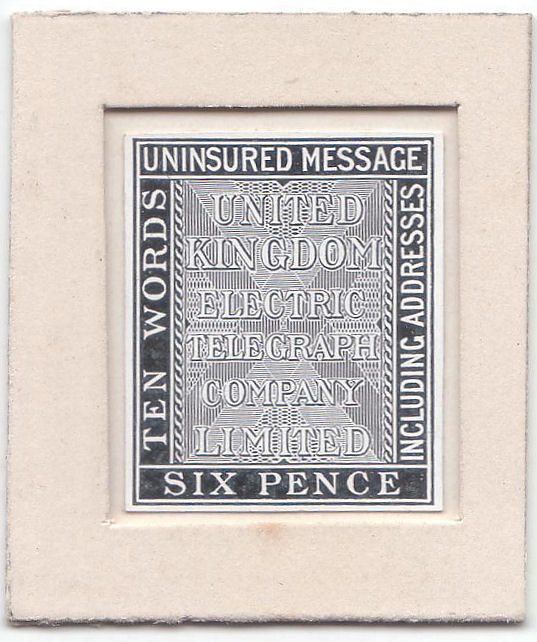
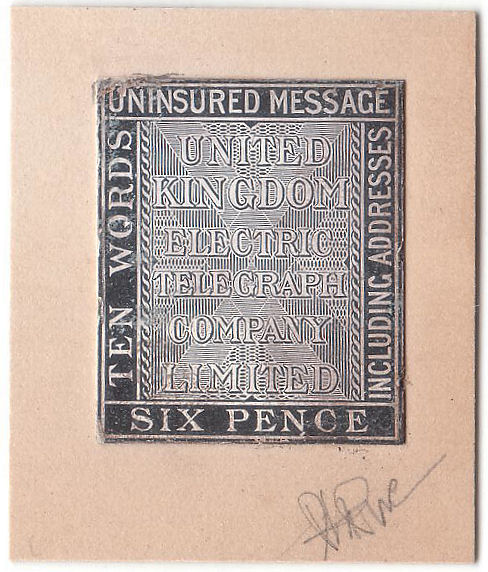
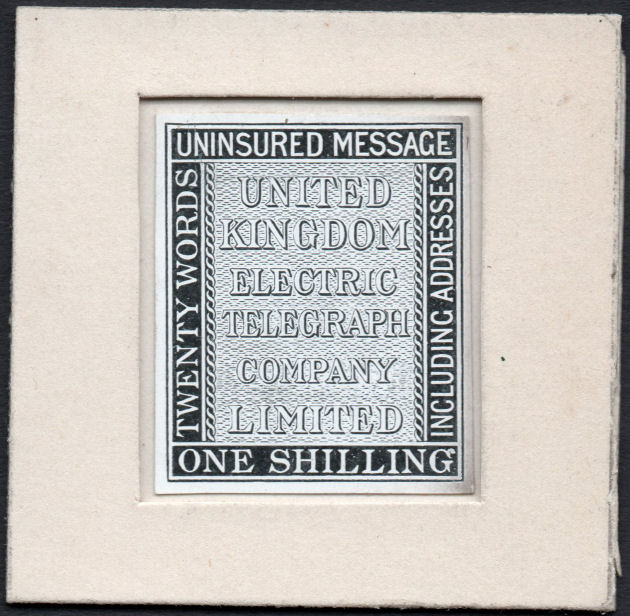
Specimens, courtesy of Steve Lawrie.
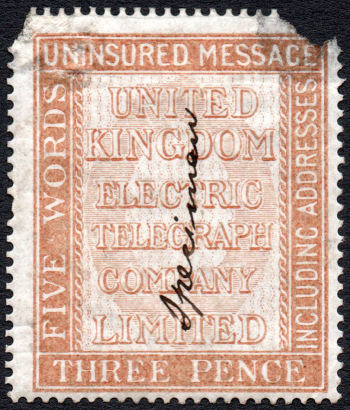
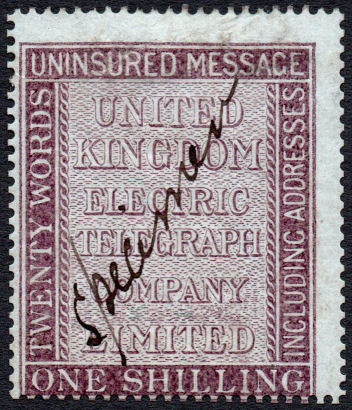
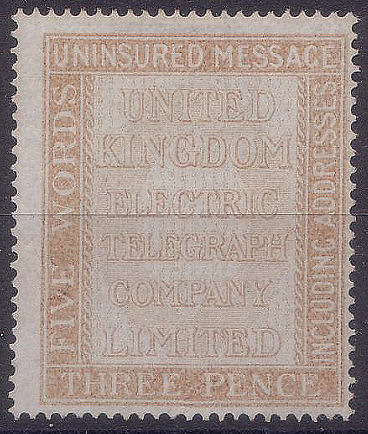
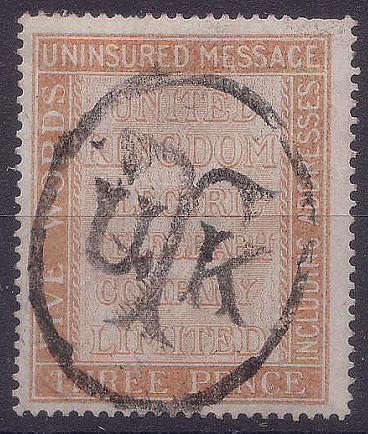
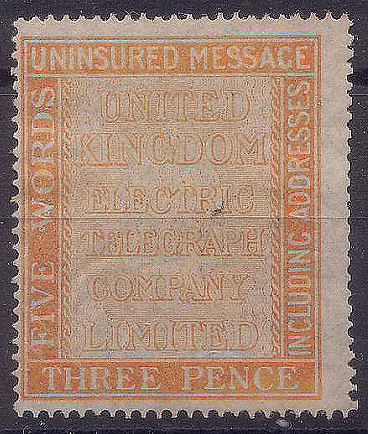
L & H list the 3d without controls only in brown-ochre, and the ones with controls only in yellow (orange-yellow ?).
The one on the right looks pretty much like orange-yellow to me - courtesy of Steve Lawrie (scanned together).
I have not yet seen any of these 3d stamps with a control number on. Can anyone provide a scan of one ?
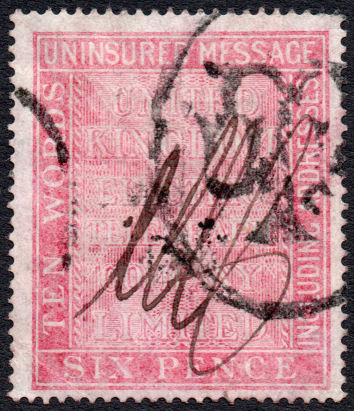
RH2a used, courtesy of Steve Lawrie.
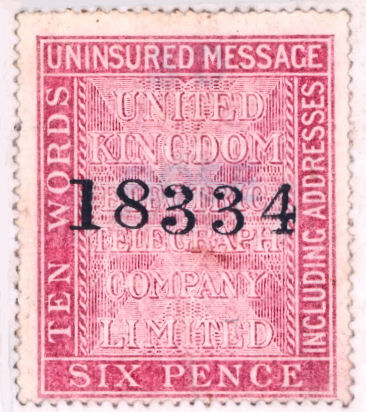 |
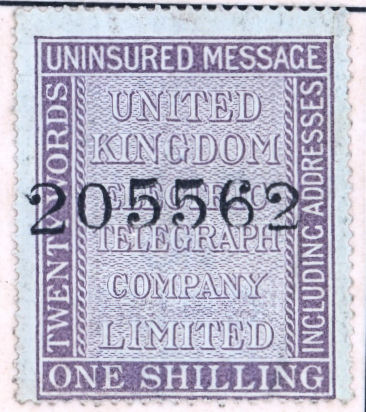 |
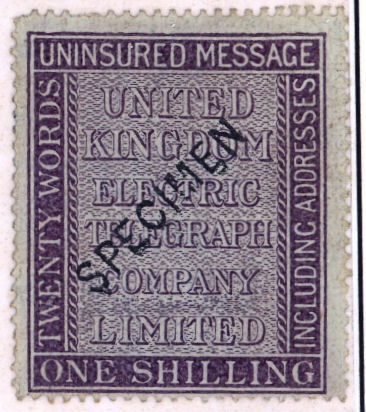 |
| 6d - RH2 | 1s - RH4 | 1s - RH4 (Specimen Type 7) |
| Images courtesy of Mark Gibson | ||
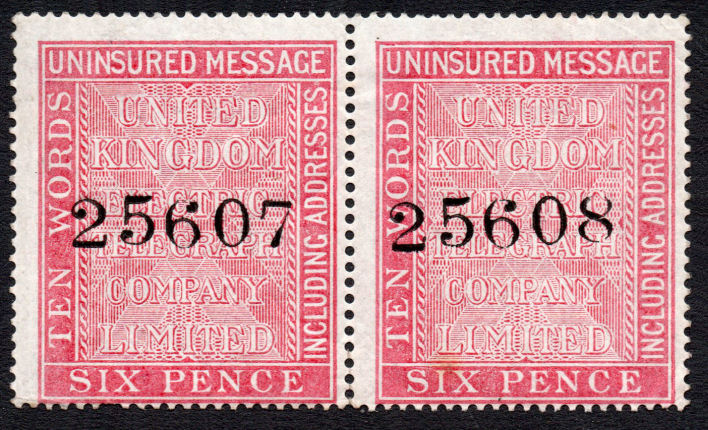 |
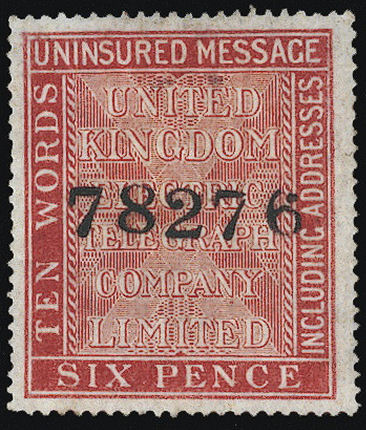 |
| 6d courtesy of Steve Lawrie showing the numbering direction. | The highest 6d number known from Langmead & Huggins (colour plate 2), courtesy of the Great Britain Philatelic Society |
It is strange here that Hiscocks list all the ones without control as more expensive, except he does not list H3 without control, which L&H say is the commonest!
Look here for an explanation of the table.
New series in a similar horizontal format,
now with conditions added.
The low pricing of the company caused fierce competition with larger companies causing poor profits.
They increased their tariffs in 1865 and brought out the stamps shown below:
The pair of 3d are actually two that were used for an illustration of black ink, so not strictly proofs.
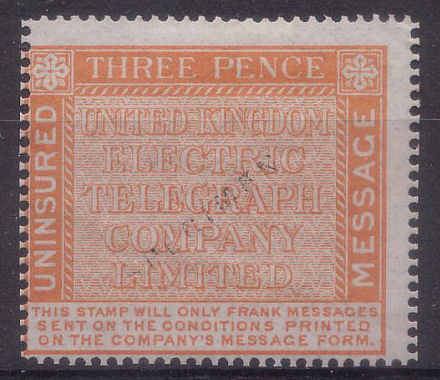
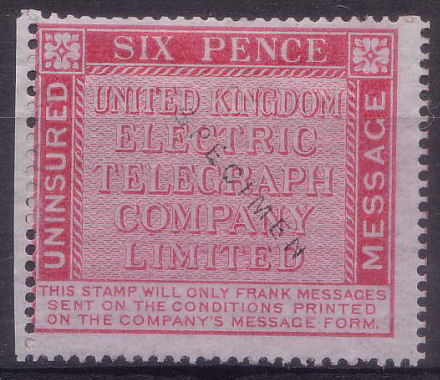
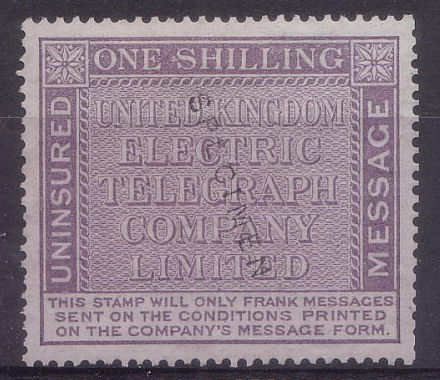
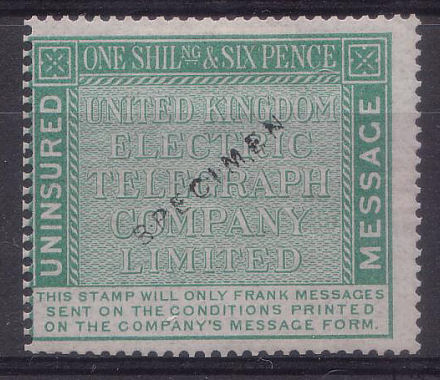
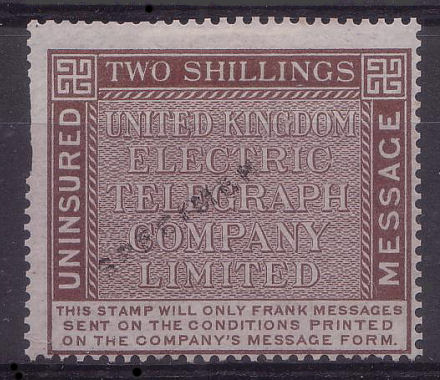
I thought that since these were produced by De la Rue I should be able to identify the specimen type, but failed miserably.

This 600dpi straightened image from the 6d gives the idea. Counting pixels, it is close to 16mm 1¾ mm.
The SG list narrows it to types 1, 2, 5, 6 or 8 for the possible dates. It looks nothing like 5. 2 and 8 are too large.
1 and 6 are nominally too large also, but are marked with an asterisk. They were around for a long time and varied. Type 1 looks closest.
Then (belatedly) I looked at L & H. They identified the specimen type as "Crown Colonies Type D5" and say that GB Type 2 is also known for the 6d.
Credit where credit's due, they beat me on that one !
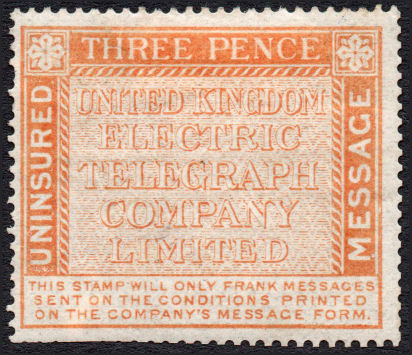
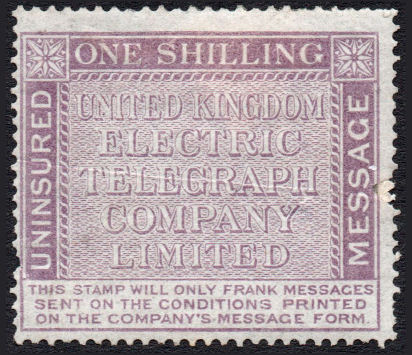
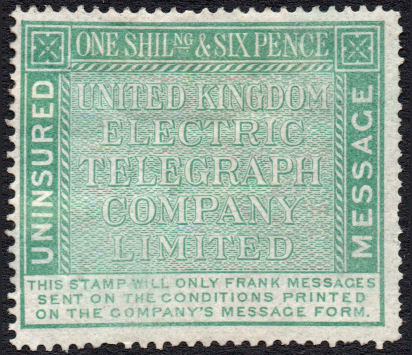
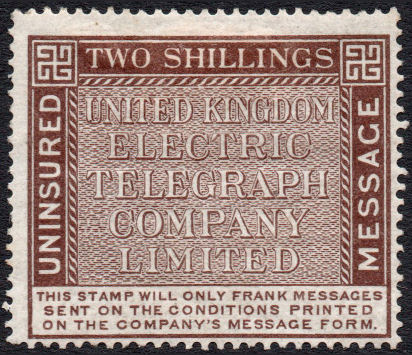
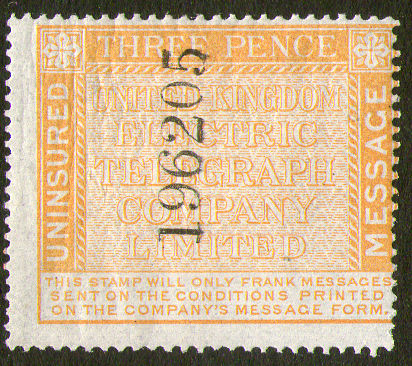 |
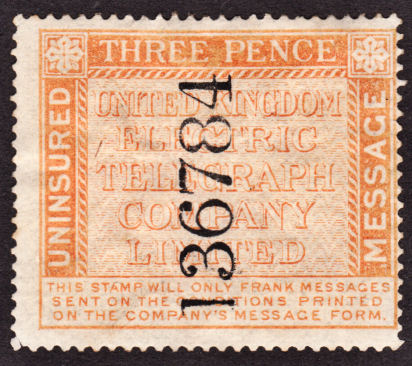 |
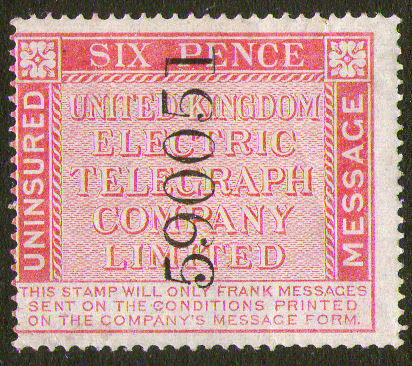 |
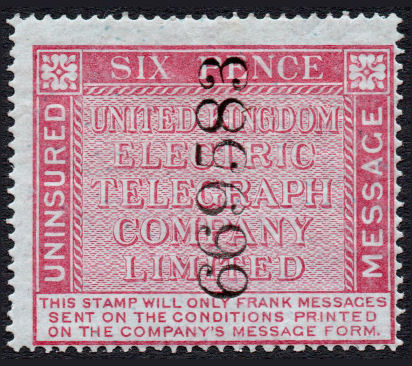 |
| 3d - 3¼mm control - RH5a | 3d - 4mm control - RH5 | 6d - 4mm control - RH6 | 6d - 4mm control - RH6a (highest known courtesy Steve Lawrie) |
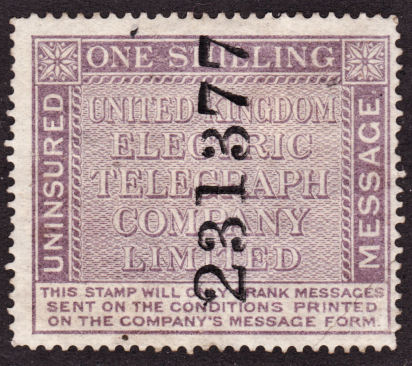 |
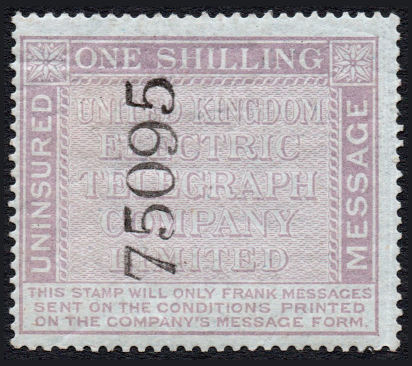 |
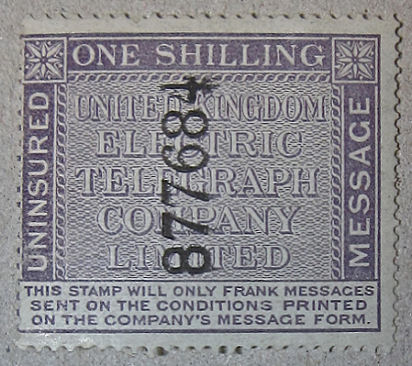 |
| 1s - 4mm control Original background - RH7 | 1s - 4mm control, blued - RH7a courtesy of Steve Lawrie |
1s - small control RH7b - Previously unlisted, courtesy of Mark Gibson |
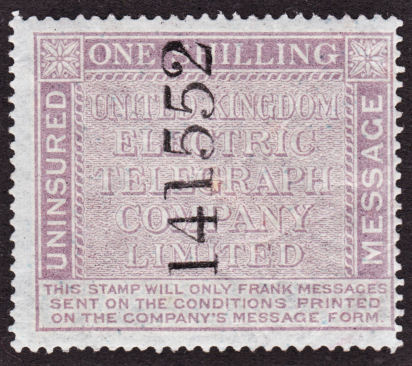 |
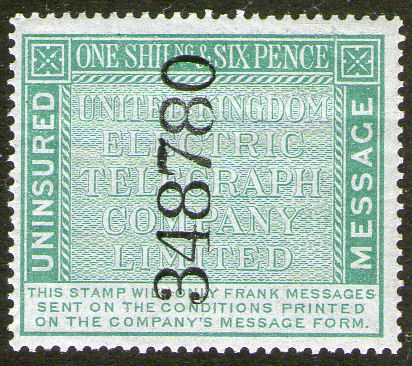 |
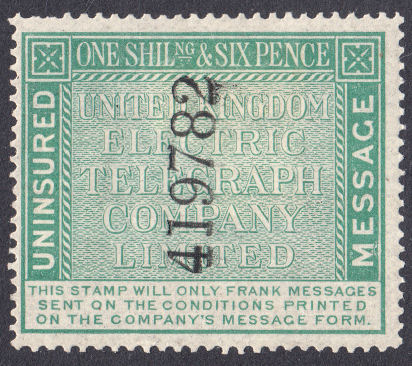 |
| 1s - 4mm control Redrawn background, blued - RH8a | 1s6d - 4mm control - RH9 | 1s6d - 3¼mm control - RH9a |
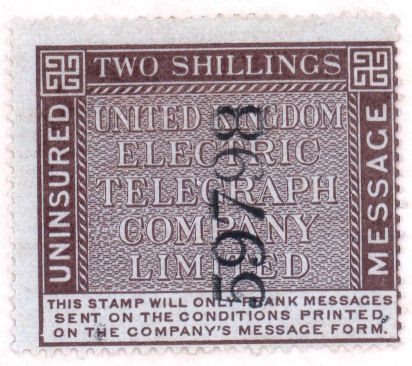 |
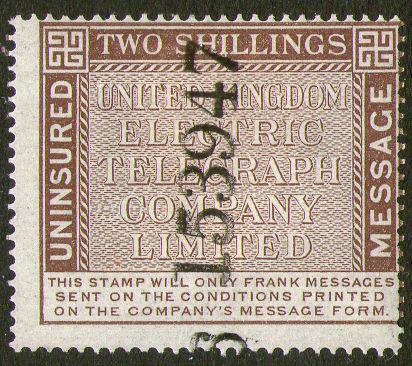 |
| 2s - 4mm (low) control, blued paper, courtesy Mark Gibson | 2s - 4mm control (slight doubling) - RH10 |
These were in values 3d, 6d, 1s, 1s6d and 2s, on white or blued paper with 4mm high control numbers.
In addition the 3d and 1s6d are also known with 3¼mm high controls.
Black Controls: Perf.15 x 15½.
Large (approximately 4mm high) controls unless otherwise stated.
| RH # | Hisc. | Horizontal Description | Rarity | Mint | *Used |
|---|---|---|---|---|---|
| RH5 | H5 | 3d orange-yellow | R2 | 25.00 | 90.00 |
| RH5a | H5a | 3d yellow (3¼mm) | R1 | 15.00 | 80.00 |
| *RH5b | - | 3d orange-yellow. No Control | Unlisted | - | - |
| RH6 | H6 | 6d rose | R1 | 12.00 | 80.00 |
| *RH6a | - | 6d rose. No Control | Unlisted | - | - |
| RH6b | 6d rose on blued paper | R2 | 25.00 | 90.00 | |
| RH7 | H7 | 1s lilac | R1 | 30.00 | 80.00 |
| RH7a | 1s lilac on blued paper | R2 | 50.00 | 90.00 | |
| RH7b | 1s lilac - small control | Unlisted | 200.00 | - | |
| *RH7c | - | 1s lilac. No Control (slightly blued) | Unlisted | - | - |
| - | H15 | 1s lilac. As H7 but Litho * | Unlisted | - | - |
| RH8 | H8 | 1s lilac redrawn background | R3 | 75.00 | 125.00 |
| RH8a | 1s lilac redrawn on blued paper | R2 | 50.00 | 90.00 | |
| RH9 | H9 | 1s6d green | R2 | 40.00 | 80.00 |
| RH9a | H9a | 1s6d green (3½mm) | R2 | 30.00 | 100.00 |
| *RH9b | - | 1s6d green. No Control | Unlisted | - | - |
| RH9c | 1s6d green on blued paper | R2 | - | - | |
| RH9d | 1s6d green, blued (3½mm) | R2 | - | - | |
| RH10 | H10 | 2s brown | R1 | 20.00 | 80.00 |
| *RH10a | - | 2s brown. No Control | Unlisted | - | - |
| RH10b | 2s brown on blued paper | Unlisted | 80.00 | - |
* Used prices quoted are for stamps with the 'UTK' cancel.
* I have listed these due to examples shown above.
I have not seen the 6d without control, other than a specimen, but it now seems likely to exist.
* Philbrick & Westoby (1881) say of this (page 339) :
"We have also seen copies of the one shilling, for which doubtless the demand was far greater than for the other values,
which are apparently lithographed from a transfer from the original plate. Though printed in the same colour as the type-printed copies,
they are readily distinguishable from the latter by the blurred background, and by the paper not having the glaze upon it as those previously described.
They were probably manufactured by another firm than that of Messrs. De La Rue and Co."
Philbrick & Westoby make no reference to a "Background redrawn" type that Hiscocks and Langmead & Huggins refer to.
Raymond Lister (1961) makes no reference to a lithographed type, but does describe the "Background redrawn" type.
I think that the two writers are referring to the same thing with different labels.
Hiscocks (1982) includes both, but prices the 'lithographed' type very high, not having seen one!
Langmead & Huggins follow Lister, probably having come to the same conclusion.
See below for as illustration of the 1s redrawn background.
Hiscocks describes this as Perf 15. no doubt copied from Philbrick & Westoby who described all these as Perf.15
The perforation of all these stamps is about 15.2 x 15.5
For the 1s6d value, the change from large controls to small took place somewhere between 348780 and 412693.
I have not seen much in the way of flaws on these to use for plating purposes, but
the 1s6d green above has a notable frame-break lower left under the second 'N' of 'UNINSURED' (2nd stamp, bottom row).
The large controls are normally quoted as 4mm high. Raymond Lister (1961) and L&H (2003) give 3½mm as the height of the small controls,
while Hiscocks (1982) says 3¼mm. In truth there is some variability. The control numbers appear to have been applied by hand and some (particularly 2s stamps)
show signs of doubling, presumably due to the numbering machine bouncing on impact, which leads to a higher measurement for control heights, sometimes more on one side than the other.
Small is thus generally 3¼mm to 3½mm and large 4mm to 4½mm. The 'INT' overprint (see below) also measures about 4mm.
When judging visually, it may be hard to tell the height on an individual stamp. One tip here is to look at the width rather than height.
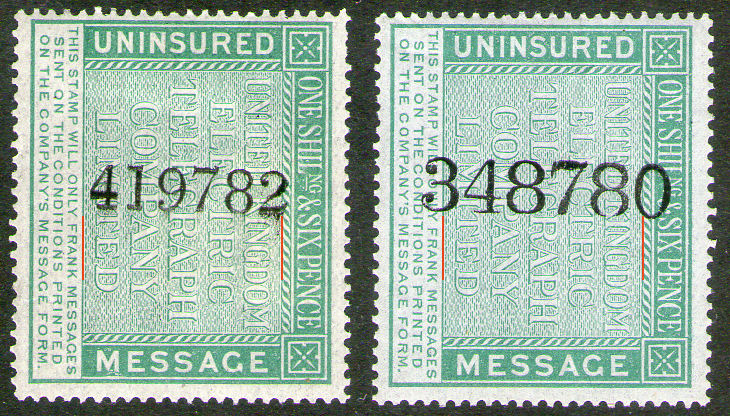 |
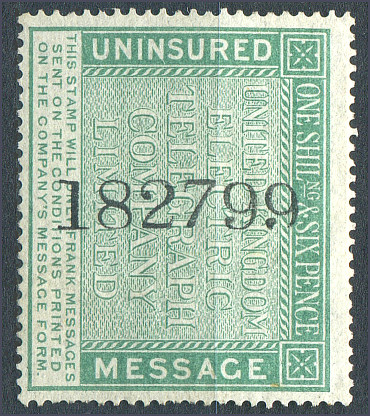 |
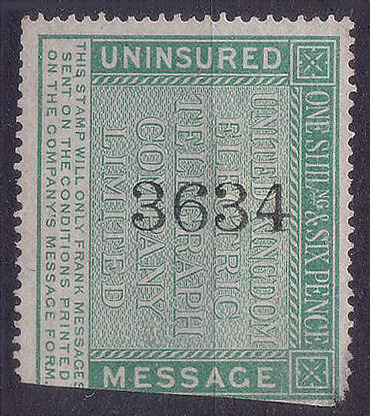 |
|
| 419782, 6 digits 3.9mm | 348780, 6 digits 4.65mm | 182799, 6 digits 4.15mm | 3634, 4 digits 4.27mm |
The sizes quoted above are about right for the 3d stamps. These 1s6d stamps though have 'small controls' that are only a little short of 4mm high.
It is probably difficult (by design) to change the numbers manually on the numbering device, so it was likely that each denomination had a dedicated numbering device.
The specific size was probably determined by what they happened to buy rather than being specified. It is not always clear though why the size changed
For the 3d, all the low numbers I have seen, 3948-136794 were large controls, then from 139441-235949 are all small numbers.
For the 1s6d, 60235-93869 are large, then comes 182799 shown above, then 218467-276729 small, 347874-349522 large, lastly 398521-420000 small.
Perhaps it was sometimes necessary to swap numbering machines, even if it was difficult, due to the loss or breakdown of one.
With the 1s, indications are that they exceeded the maximum count and started again. Without dated pieces, the sequence of sizes is unclear.
For 6-digit control numbers (which is most of them), the small control should just about be able to fit within the frame, but the large control is much too wide.
Make some allowance if the number has a '1' at the beginning or end, or if the control has less than 6 digits.
Image of 182799 courtesy of Grosvenor Auctions (Ex. Iain Stevenson).
Image of 3634 courtesy of Steve Lawrie.
For the 6d and 2s, they appear to have only ever used large controls, but perhaps not always the same 'large controls'.
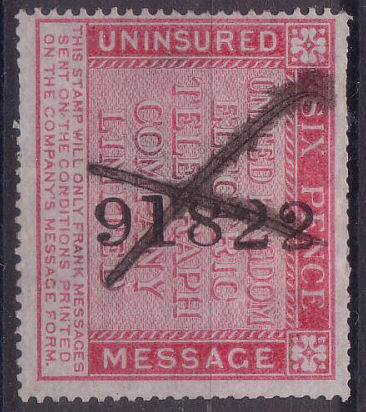
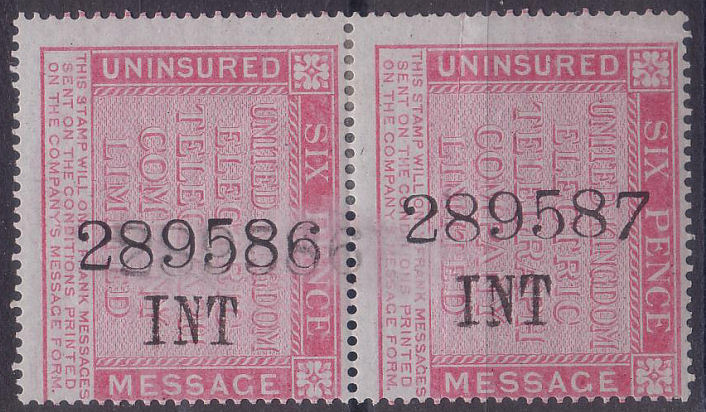
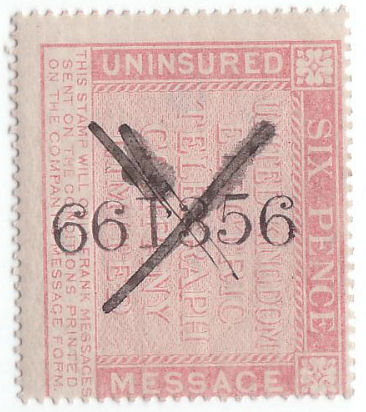
The earlier ones seem to have a different style of control than the later ones (note the '2's). The left is the lowest 6d number I have seen, the right is the highest.
Images courtesy of Steve Lawrie.
In the early days of the new format, the company was suffering financially and couldn't pay dividends.
Instead they provided Telegraph stamps in lieu to their shareholders. These are overprinted 'INT' for 'Interest'.
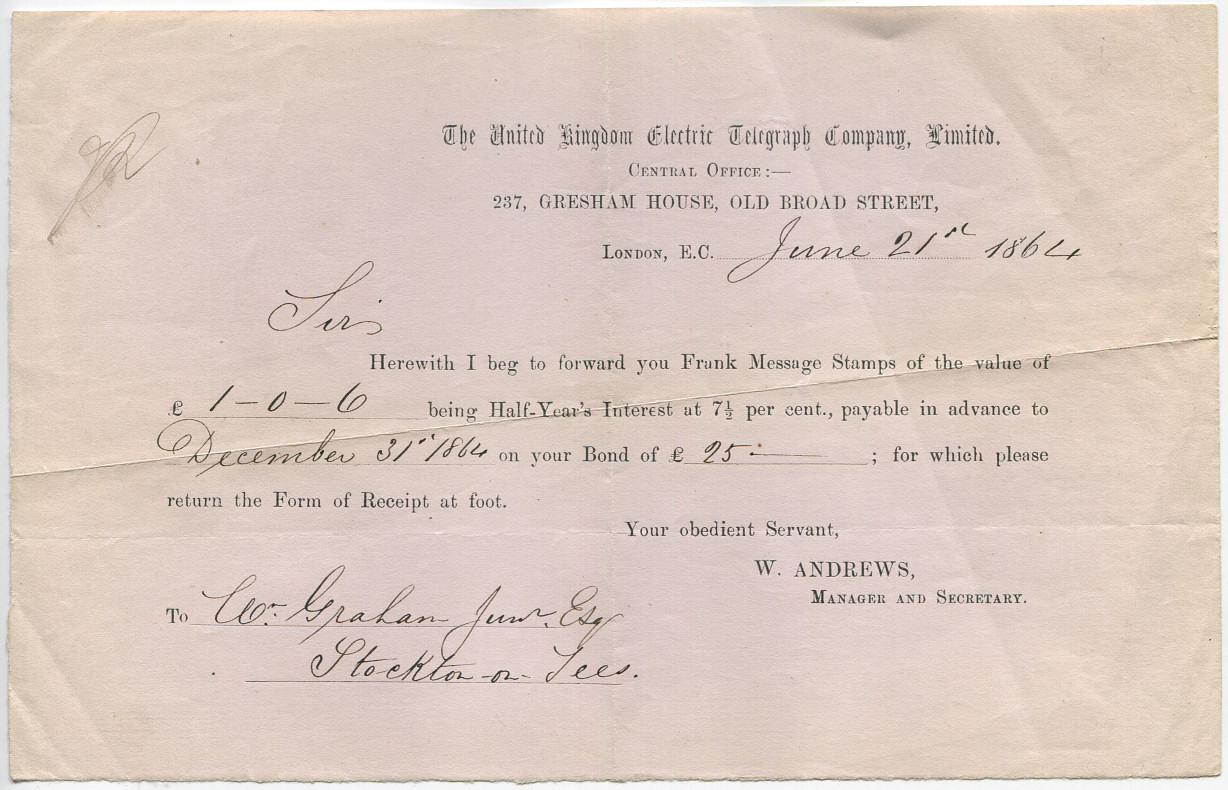
Image courtesy of Grosvenor Auctions (Ex. Iain Stevenson). I don't make 7½% of £25 to be £1-0-6d though.
Not all bonds were paid in stamps. The form below dated 22 January 1864 shows £5 being paid for a Bond into a bank account.
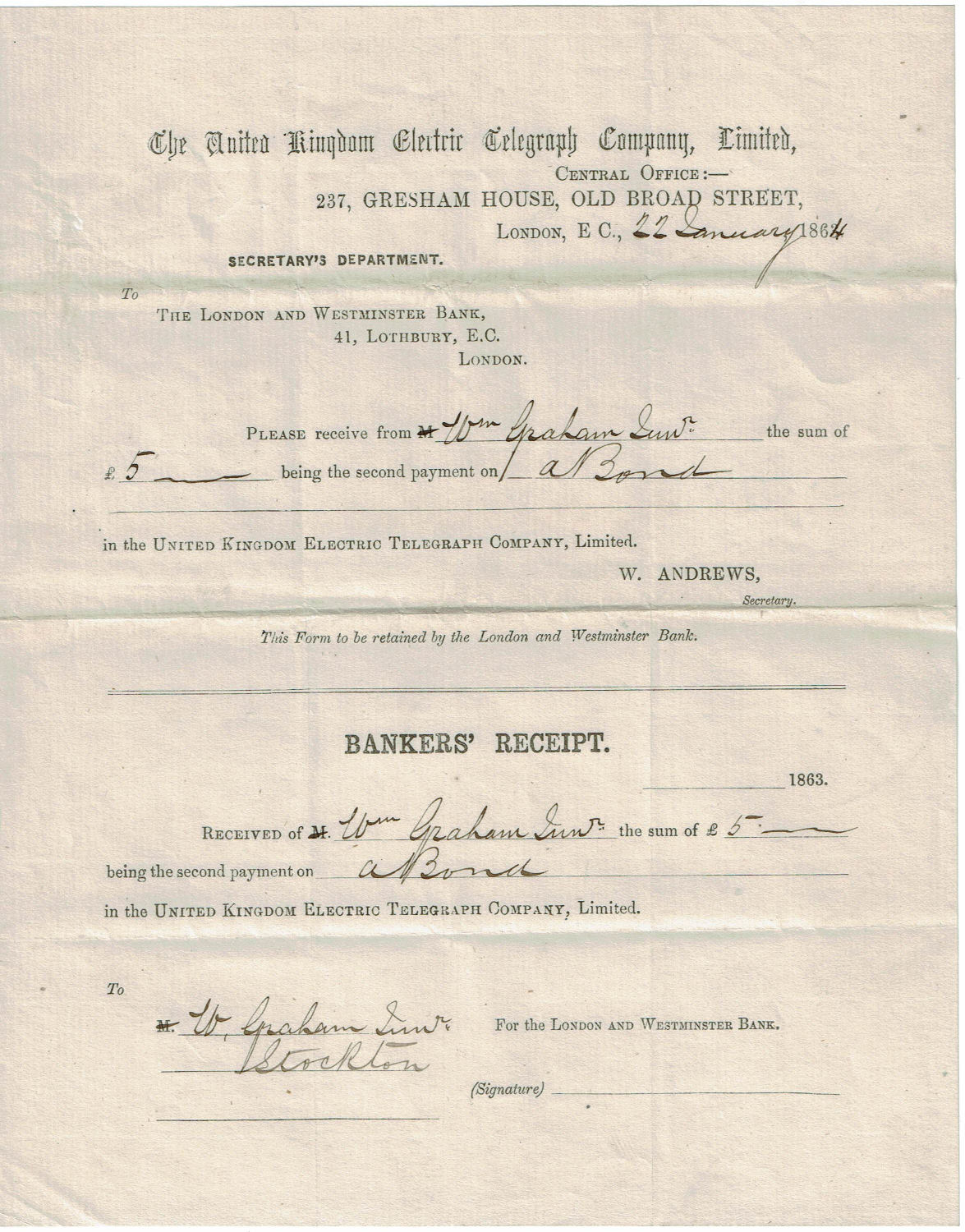
Image courtesy of Edward Coombes.
The letters of 'INT' can have wide (9mm across top) or close spacing (7½ to 8mm across top).
I think the wide spacing came later, but it looks the other way around on the 1s because the maximum count was reached and the numbering restarted.
The 1s one below is Control 112159.
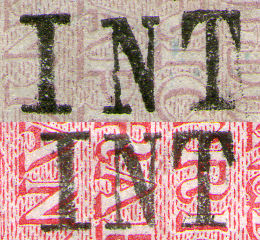
A comparison of the 'wide' and 'close' INT.
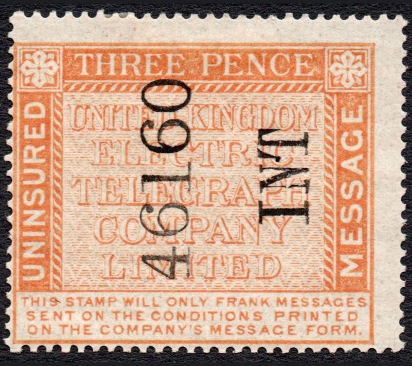 |
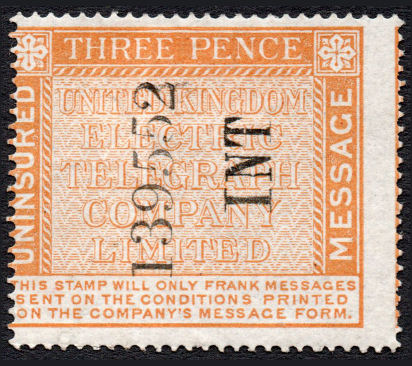 |
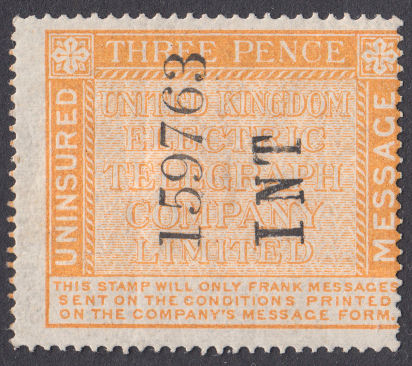 |
| 3d - 3½mm control 'Close INT' RH11 (courtesy of Steve Lawrie) |
3d - 3mm control 'Close INT' RH11a (courtesy of Steve Lawrie) |
3d - 3mm control 'Wide INT' RH11b |
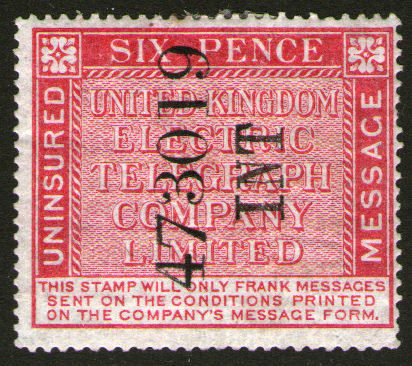 |
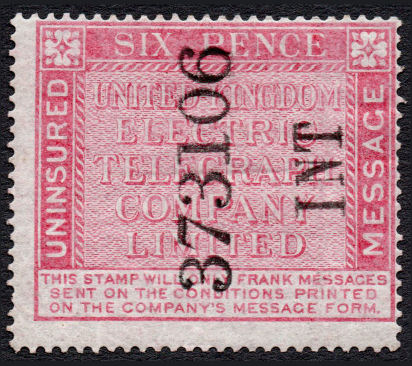 |
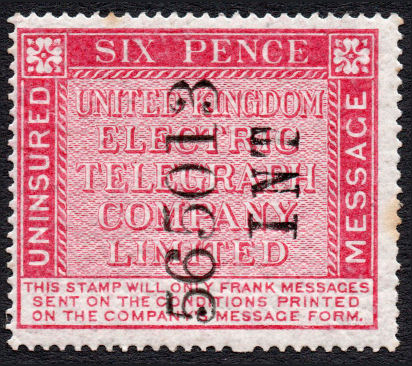 |
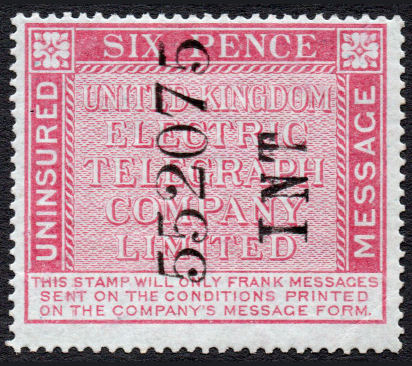 |
| 6d - 4mm control 'Close INT' RH12 | 6d - 4mm control 'Close INT'' (slightly blued) RH12a (courtesy of Steve Lawrie) |
6d - 4mm control 'Wide INT' RH12b (courtesy of Steve Lawrie) |
6d - 4mm control 'Wide INT' (slightly blued) RH12c (courtesy of Steve Lawrie) |
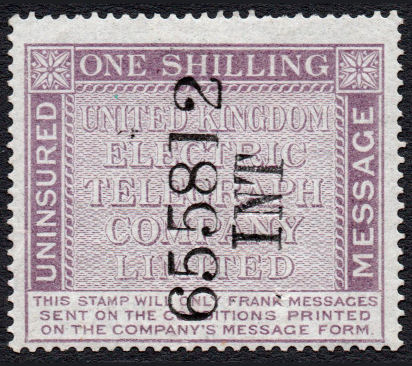 |
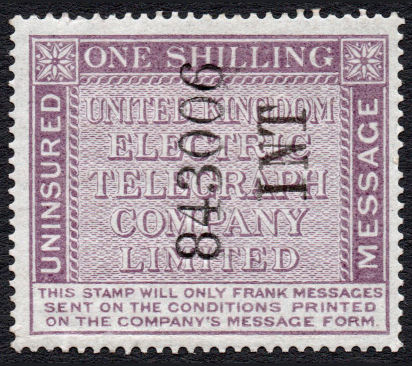 |
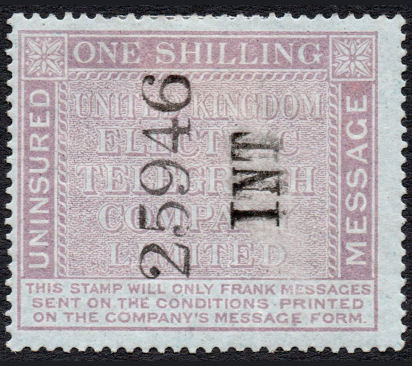 |
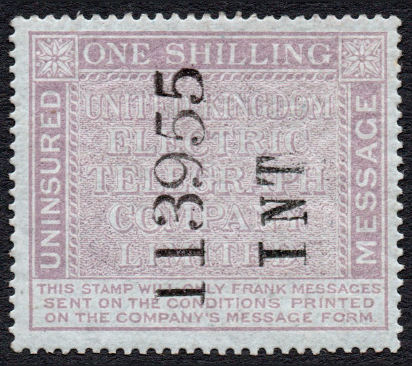 |
| 1s - 4mm control 'Close INT' RH13 courtesy of Steve Lawrie |
1s - small control 'Close INT' RH13a courtesy of Steve Lawrie |
1s redrawn- 4mm control 'Close INT' (slightly blued) RH14 lowest known control - courtesy of Steve Lawrie |
1s redrawn- 4mm control 'Wide INT' (slightly blued) RH14a courtesy of Steve Lawrie |
There are a lot of permutations with the 1/-. Ordinary/Re-drawn, Large/Small control, Wide/Close INT and White/Blued paper. Not all permutations are recorded, e.g. small controls are only known Ordinary, White, Close.
Controls Large(≈4mm high) or small (≈3½mm high) with 'close INT' (7½ to 8mm) or 'wide INT' (9mm). Perf.15 x 15½.
*Used prices quoted are for stamps with the 'UTK' cancel.
There are clearly differences of opinion here.
Hiscocks does not differentiate between blued and white paper here, L&H does but assigns them the same rarity.
Hiscocks says there is a single 1s value with small control and it has the original background.
L&H say it has an original background in the text, but redrawn background (on blued paper) in the rarity guide.
Mark Gibson has supplied a 1s stamp with small control shown above, it has a redrawn background but does not look very blued to me.
Does anyone have 1s 'INT' with small control and the original background ?
I have to say H12 definitely exists, I illustrate one.
I have also seen 2s stamps that definitely show signs of bluing. Is that significant?
L&H say ALL the 1s stamps with a redrawn background are on blued paper, so perhaps it is.
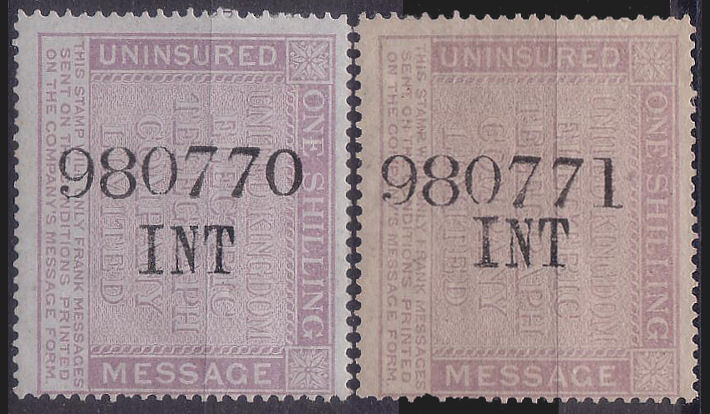
Here are two stamps from the same scan of some of Steve Lawrie's stamps. Did they once fit together? What colour was the paper?
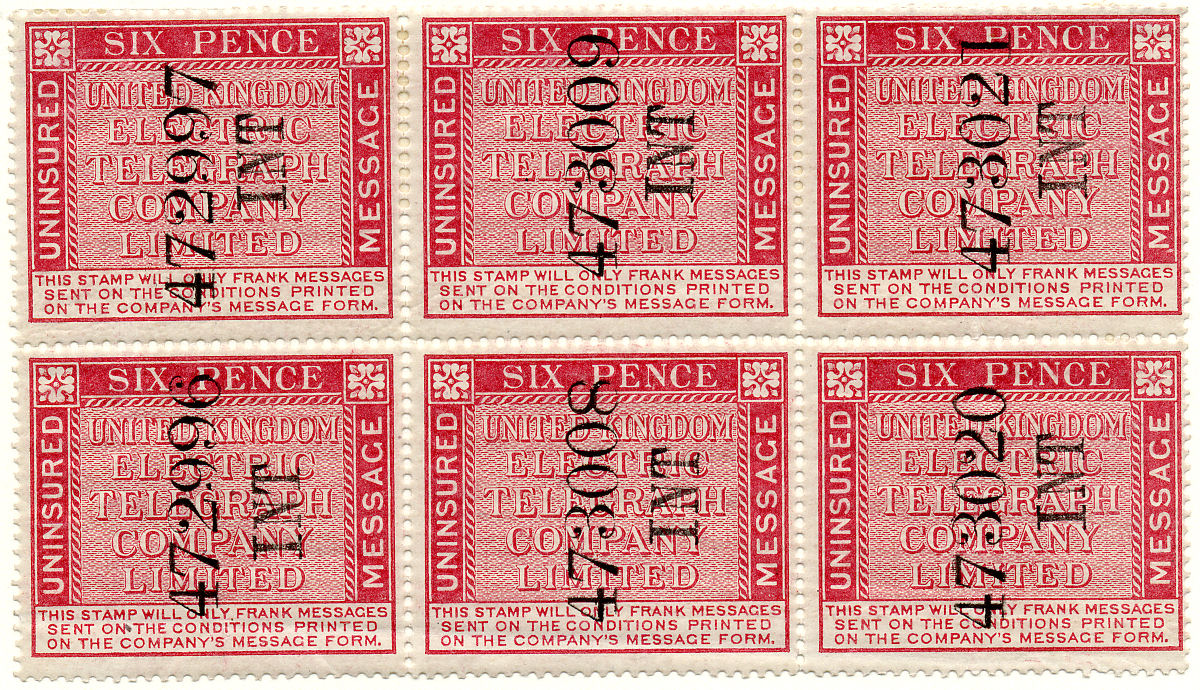
This block (courtesy Mike-Holt.com) demonstrates the comb perforation, and the control numbering scheme. There were 12 rows of 10 stamps in the sheet.
It also demonstrates that they exist on white paper, contrary to what L & H would have us believe.
These are 6d rose with the large control and the 'Close INT' overprint. According to Langmead & Huggins, they only exists on blued paper.
Hiscocks makes no mention of it being blued.
I know bluing can sometimes be in the eye of the beholder, but if this is considered blued paper then I don't think I have any stamps on white paper!
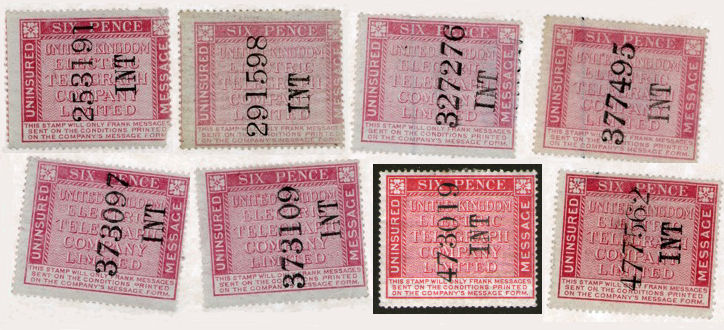
L & H do not list this 6d on white paper (RH12). Here is a selection courtesy of Mark Gibson that I have rearranged into Control number sequence and inserted mine.
It can be seen that the earlier ones were blued, but not the later ones. My one with the black outline adjoins the block shown above.
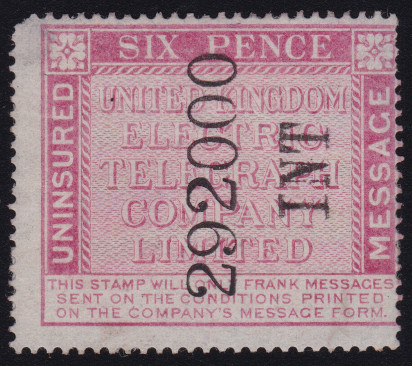
Here is one that I got recently. It had not occurred to me to say this was blued paper until I saw that all the stamps around 292000 were described as such !
Blued? Really? When I check the colour components, blue is the lowest just about everywhere on it, with red the highest. Off-white might be a better description.
Cyan paper would be a better description, but to me the most noticeable feature is the shade of the 'red'. The earlier ones are perhaps better described as rose-carmine.
Enter a Control number to check
| Sheet (1+) | Row (1->12) | Column (1->10) |
|---|---|---|
| Controls for sheet: | ||
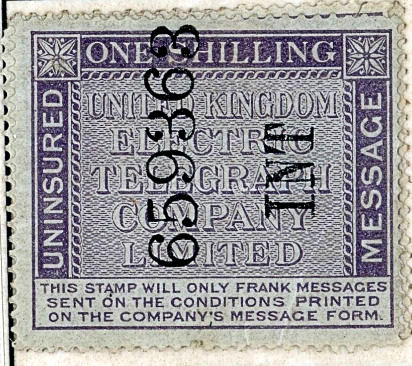 |
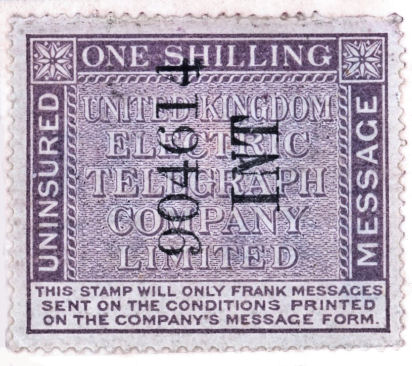 |
| 1s - 4mm control Original background, blued RH13c | 1s - 3¼mm control Original background RH13a |
| These 2 images courtesy of Mark Gibson | |
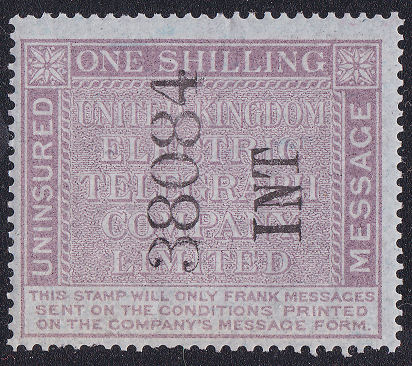 |
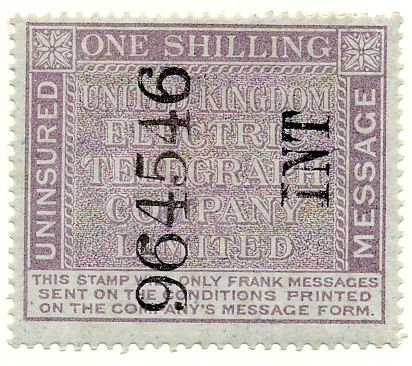 |
| 1s - 4mm (low) control Redrawn background, blued RH14 | 1s - 4mm (high) control Redrawn background, blued RH14 |
| One of mine | Image courtesy Mike-Holt.com |
This shows that bluing (to some extent) can occur on both low and high control numbers. The numbers probably reset at 999,999
At some stage, the background to the 1s value changed. It is normally described as 'redrawn', but according to Langmead & Huggins,
De La Rue (who made the plates) make no mention in their records of any alterations.
Personally I don't find Figs.45 and 46 on page 32 as good as they could be.
The background on the original 1s is fairly regular, whist the new 1s type looks fairly random.
Also the redrawn ones are generally paler and redder in colour.
Images courtesy of Mark Gibson.
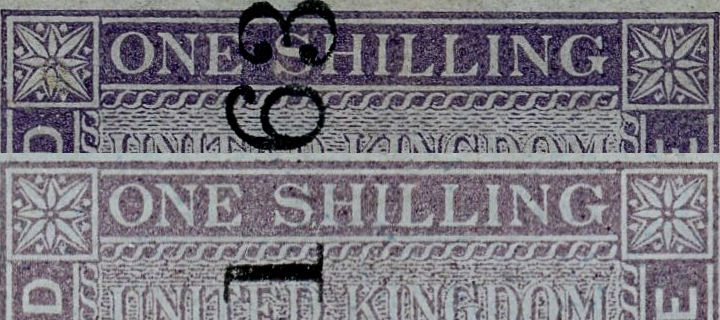
Raymond Lister (1961) adds the useful comment:
"The redrawn background may be recognised by the fact that the horizontal lines forming part of it are joined together here and there
by small vertical lines. In the original background these vertical lines are missing, so that one could, so to speak, move from left to right without crossing a line."
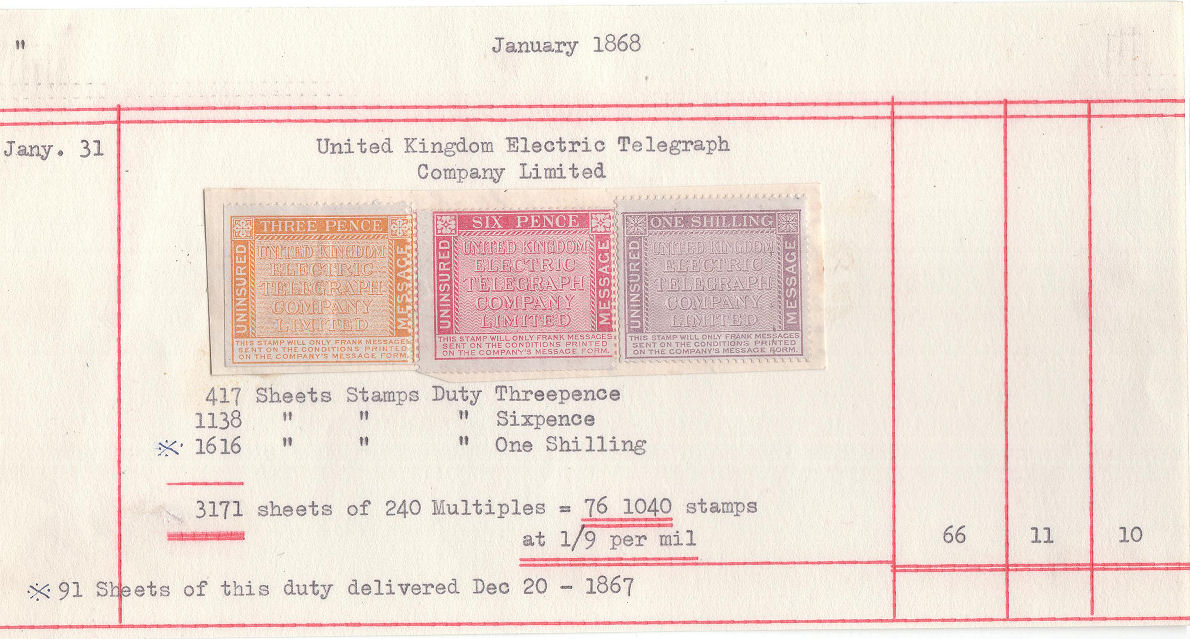
According to Langmead & Huggins, printings of this Shilling stamp were:
18 July 1864 - 227520 ( 948 sheets of 240)
30 April 1865 - 446640 (1861 sheets of 240)
31 January 1868 - 387840 (1616 sheets of 240)
Since 1861, including the vertical format, they had been getting supplies every year.
They did not get any in 1866 and their 6-monthly bonds were due to be paid in stamps by the end of December 1867.
This snippet from the De La Rue books (courtesy of Steve Lawrie) show that of the 1616 sheets mentioned by L&H, 91 sheets were delivered early on 20 December 1867.
This suggests to me a bit of an emergency, perhaps the most likely time to find an alternate source of One Shilling stamps.
Since I cannot see every stamp they ever printed, I will try to show ranges based on examples seen and the
assumption that all stamps on the same sheet were of the same type.
I hope to match-up the alternating normal and 'INT' stamps with the twice-yearly issue of bonds on 30 June and 31 December. This will help in the dating process.
| 3d 12/9/65 |
Controls numbers | range | control | INT | paper | UKET RH# |
L&H Rarity |
|---|---|---|---|---|---|---|---|
| 3948 | 1 | large | close | white | 11 | R3 | |
| 43685, 44543, 44623 | 939 | large | - | white | 5 | R2 | |
| 46147, 46149, 46160, 60652, 75202 | 29160 | large | close | white | 11 | R3 | |
| 77161-77280, 100427, 111241-111360, 124351, 125985, 136784, 136794, 136797 | 59634 | large | - | white | 5 | R2 | |
| 139441-139680, 155881-156000 | 16560 | small | close | white | 11a | R3 | |
| 159721-159840 | 120 | small | wide | white | 11b | R3 | |
| 164025, 174042, 174610, 175321-175440, 190552, 193921-194160, 196081-196440, 199561-199680, 232561-232800, 233761-233880, 235780, 235801-235920, 235949 | 71925 | small | - | white | 5a | R1 |
| 6d 18/7/64 |
Controls numbers | range | control | INT | paper | UKET # |
L&H Rarity |
|---|---|---|---|---|---|---|---|
| 91822, 103906, 110667, 128182, 217375 | 125553 | large | - | blued | 6a | R2 | |
| 227041-227160, 233041-233160, 253191 | 26151 | large | close | blued | 12a | R2 | |
| 273813, 273950 | 137 | large | - | blued | 6a | R2 | |
| 283551, 285121-285360, 289586-289587, 291421, 291434, 291598, 292000 | 8047 | large | close | blued | 12a | R2 | |
| 299095, 299097 | 3 | large | - | blued | 6a | R2 | |
| 325472, 327276 | 1804 | large | close | blued | 12a | R2 | |
| 336470 | 1 | large | - | blued | 6a | R2 | |
| 336479 | 1 | large | close | blued | 12a | R2 | |
| 353344 | 1 | large | - | blued | 6a | R2 | |
| 369883, 373081-373200, 374290, 375916, 379444-379481, 381338, 382254 |
12480 | large | close | blued | 12a | R2 | |
| 412365, 412377, 412384, 412387 | 21 | large | - | white | 6 | R1 | |
| 420361-420480, 422263 | 1903 | large | close | white | 12 | NL | |
| 433225, 451370, 453693 | 20469 | large | - | white | 6 | R1 | |
| 466081-466200, 472921-477600 (11 stamps), 478890 | 12810 | large | close | white | 12 | NL | |
| 490861, 490865 | 5 | large | - | white | 6 | R1 | |
| 519653, 529297, 529687, 534120 | 14468 | large | close | white | 12 | NL | |
| 541229 | 1 | large | - | white | 6 | R1 | |
| 552001-552120 | 120 | large | wide | blued | 12c | R2 | |
| 564961-565080, 566014, 566144 | 1184 | large | wide | white | 12b | R2 | |
| 589921-590160, 593281-593400, 594003 629698, 636044, 638161-638280, 638921, 641521-641640, 643321-643440, 661201- 661440 |
71520 | large | - | white | 6 | R1 | |
| 669583 | 1 | large | - | blued | 6a | R2 |
| 1s 18/7/64 |
Controls numbers | range | R/O | control | INT | paper | UKET # |
L&H Rarity |
|---|---|---|---|---|---|---|---|---|
| 25946, 38084, 38091, 48228, 49490, 50541 | 24596 | R | large | close | blued | 14 | R2 | |
| 66118, 75095, 75101 | 120 | O | large | - | blued | 7a | R2 | |
| 81961-82080 | 120 | ? | large | - | white? | 7/8 | R1/R3 | |
| 93384, 105814, 112159, 113881-114000 | 20640 | R | large | wide | blued | 14a | R2 | |
| 140841, 141481-141600 | 840 | R | large | - | blued | 8a | R2 | |
| 159841-160758, 231311,231377, 233166, 249079, 317786, 317801, 317805, 322390, 381375, 389355, 431145 483961-484080, 507998, 508001, 516873 | 357033 | O | large | - | white | 7 | R1 | |
| 556201-556320, 587758, 600121-600240, 633401, 649824, 655681-655812, 658870 | 102670 | O | large | close | white | 13 | R2 | |
| 659281-659400 | 120 | O | large | close | blued | 13c | R2 | |
| 661801-661920 | 120 | O | large | close | white | 13 | R2 | |
| 665757 | 120 | ? | large | close | white | 13? | R2 | |
| 676378, 681958 (used), 699429 | 23160 | O | large | - | white | 7 | R1 | |
| 726048 | 120 | O | large | close | white | 13 | R2 | |
| 752161-752280, 752390, 752393, 752396 | 240 | O | large | - | white | 7 | R1 | |
| 832859, 842997/8, 843017-843054, 846764, 847356, 848029 | 15240 | O | small | close | white | 13a | NL | |
| 877681-877800 | 120 | O | small | - | white | 7b | NL | |
| 904614, 908199, 908201, 908204 | 3600 | O | small | close | white | 13a | NL | |
| 918221 | 120 | R | large | - | blued | 8a | R2 | |
| 937930 | 120 | O | large | - | white | 7 | R1 | |
| 964441-964560, 968407, 973450, 978235, 980761-980880 | 16440 | R | large | close | blued | 14 | R2 | |
| 981836 | 120 | O | large | close | white | 13 | R2 | |
| 999838, 999843, 999844, 999853 (this sheet spans 999841-999960) | 120 | R | large | - | blued | 8a | R2 |
| 1s 6d 12/9/65 | Controls numbers | range | control | paper | UKET # | L&H Rarity |
|---|---|---|---|---|---|---|
| 60235, 60278, 74841, 89946, 93855, 93869, 182799 | 122564 | large | white | 9 | R2 | |
| 218467, 230104, 246841-246960, 276729 | 58263 | small | white | 9a | R2 | |
| 347874-348791 (39 stamps), 348767-779, 349520, 349522 | 1649 | large | white | 9 | R2 | |
| 398521-398640, 402829, 402841, 412693, 413197, 413871 416041-416160, 419761-420000 |
21480 | small | white | 9a | R2 |
| 2s 12/9/65 | Controls numbers | range | control | paper | UKET # | L&H Rarity |
|---|---|---|---|---|---|---|
| 17876 | 1 | large | blued | 10a | NL | |
| 30231, 59761-59880, 60110, 72001-72240, 72649, 72675, 121913, 126413, 143521-143640, 143952-154074 |
94313 | large | white | 10 | R1 |
It has to be said that some of the bluing is very slight. I agree with L & H that the 1s stamps reached the maximum count and re-started.
A 1s stamp, number 245035 is known used on a form dated 22 October 1864.
I have not seen any 1/6d stamps with blued paper, though on some the paper is less cream. L&H rate blued and white paper as equal scarcity.
The 'R/O' column on the shilling stamps indicates Re-drawn or Original background.
'NL' in the 'L&H Rarity' column indicates that it is not listed by them.
The alternating Normal/INT pattern can be seen clearly on the 6d. It is more confused with the 1s value for 3 reasons.
The control numbers reached the maximum count and started again, the bluing is rather subjective and may be mis-reported, and it is not always clear from scans
whether the stamp is re-drawn or not.
There must be quite a few INT issues that are not represented in this list yet.
These are useful in showing the control number layout on the sheet. The fact that they appear sideways was probably a hangover from the vertical format.
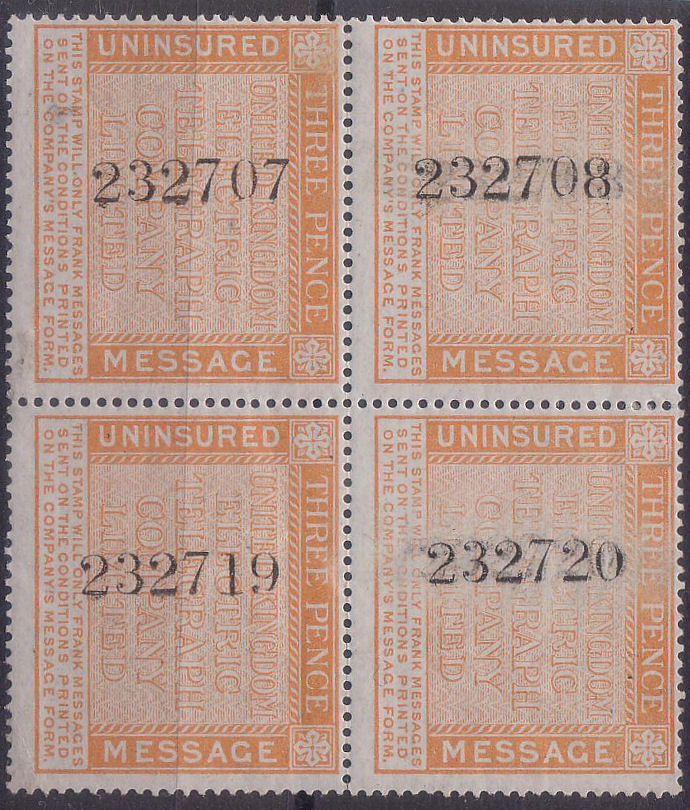 |
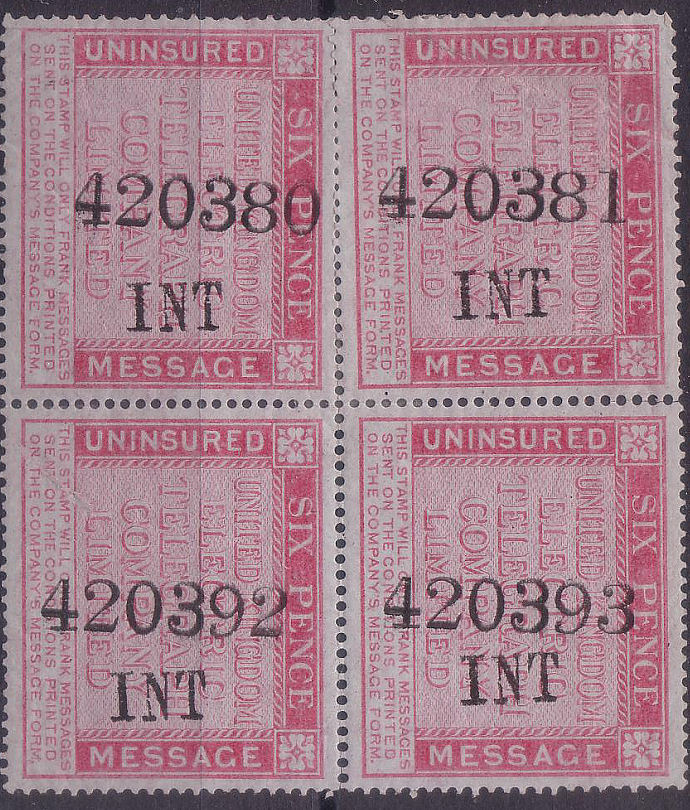 |
|
3d (small controls) this seems to have had two control numbers changed, though strangely the new numbers look the same as the old numbers. Courtesy of Steve Lawrie. |
6d large controls with 'close INT'. Courtesy of Steve Lawrie. |
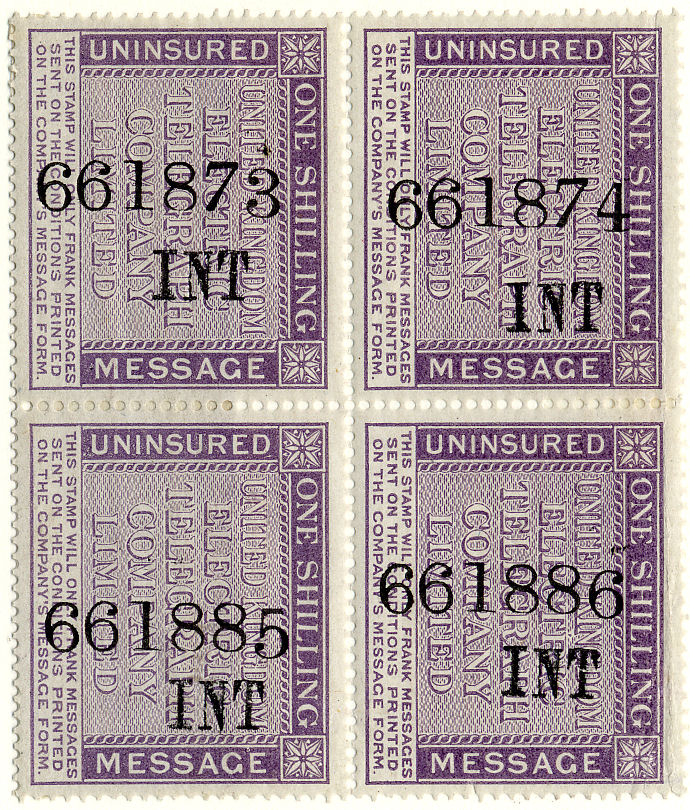 The control numbers and 'INT' were applied by hand rather haphazardly. |
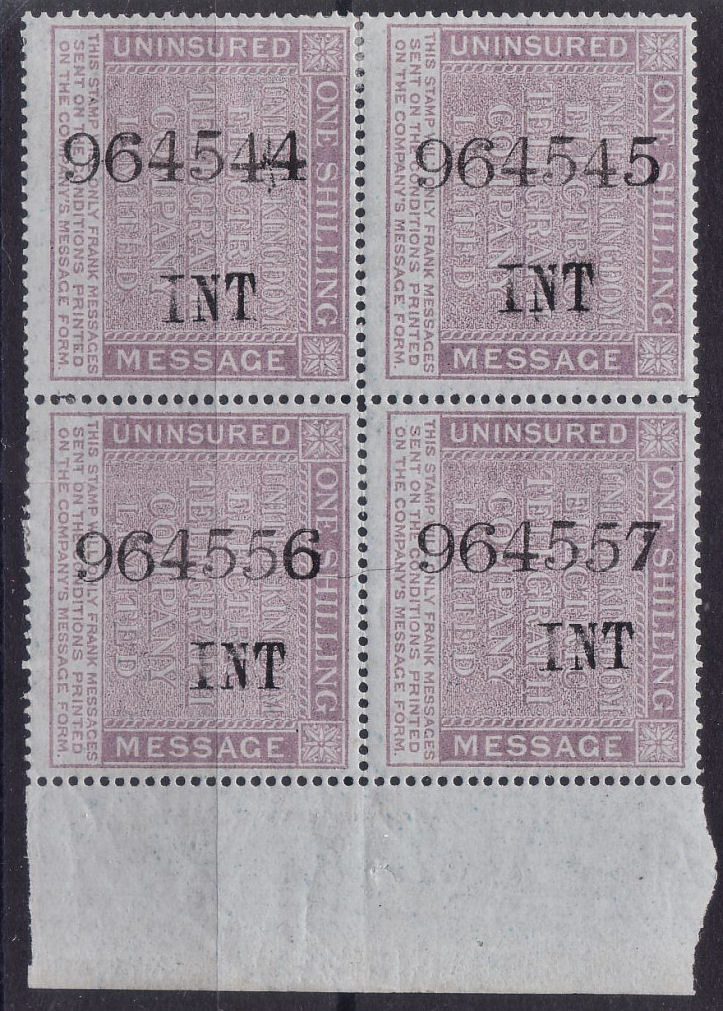 |
| 1s with original background. (courtesy Mike-Holt.com | 1s with redrawn background. (courtesy Steve Lawrie) |
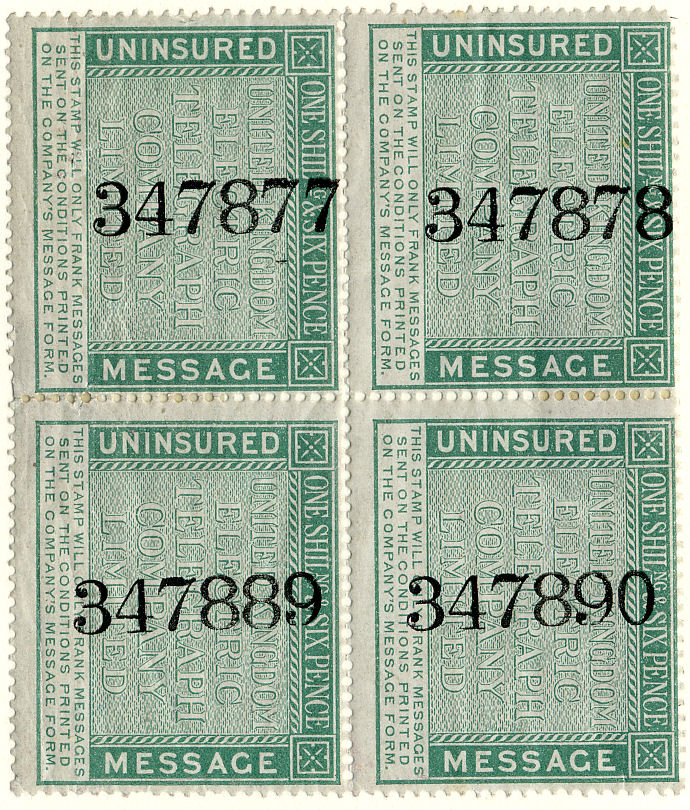 |
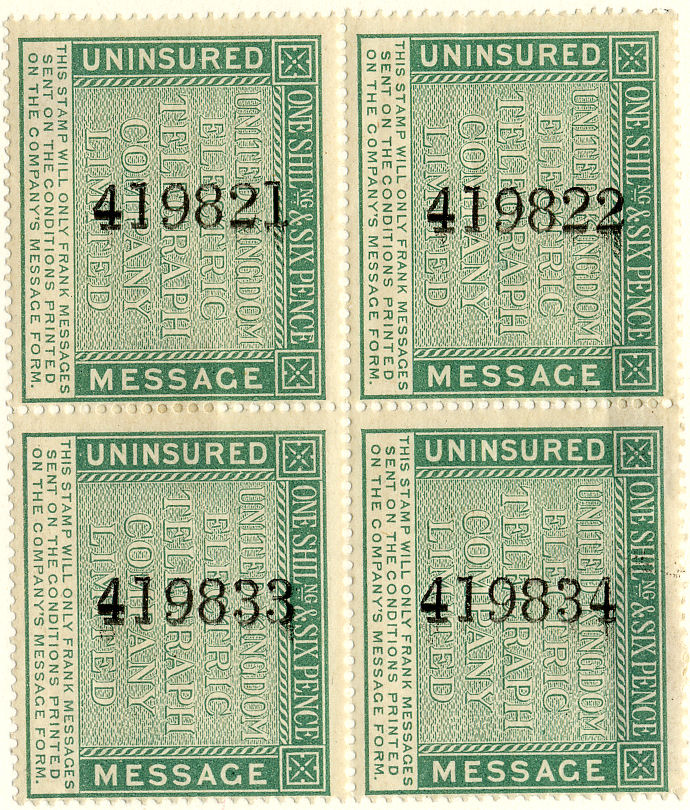
|
| These blocks (courtesy Mike-Holt.com) demonstrate in their numbering, that the small controls may be later than the large. I have seen no evidence of controls higher than 420000 on these. |
|
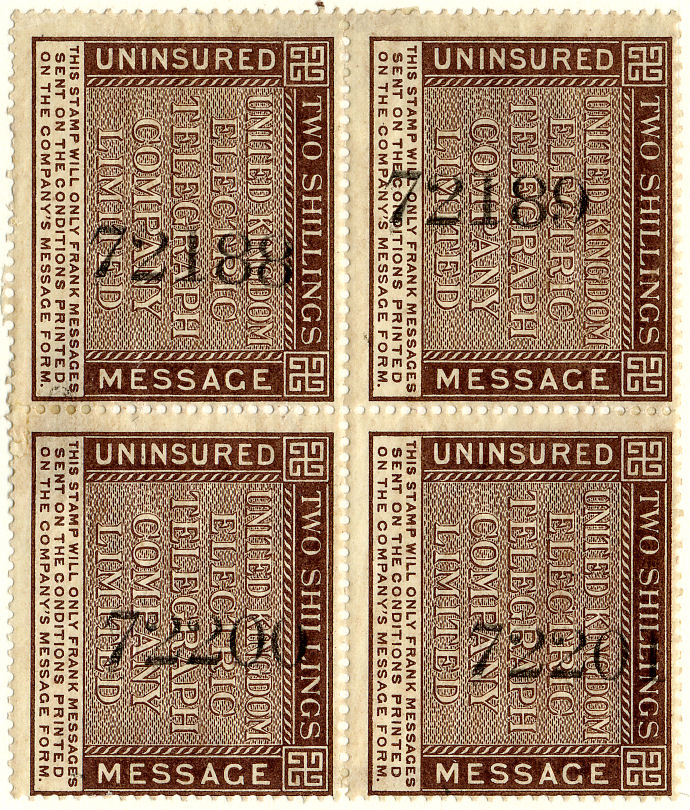
Two Shilling block with large control (courtesy Mike-Holt.com) demonstrates with haphazard arrangement, that the control numbering was done by hand.
This mark has been stamped on a list of offices on a Delivery Form.
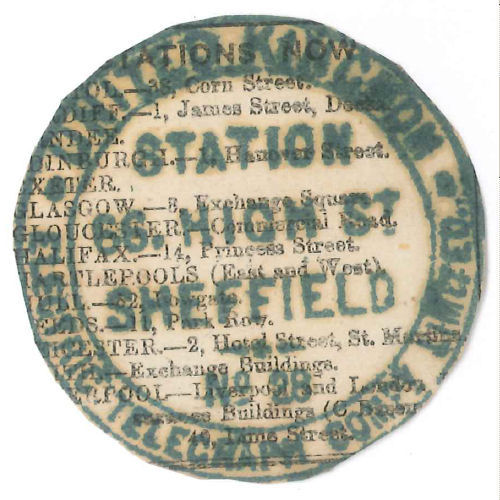
It was also sometimes used to cancel stamps on Forwarding forms at least as early as 1864
Courtesy of Mark Talbot, bought from Steven Allen off eBay.
According to Steve Hiscocks, the De la Rue archives refer to the production of 6 of these brass obliterators with wooden handles,
complete with mahogany boxes and inking pads on 10 December 1861.
These appear to be proofs of cancels.
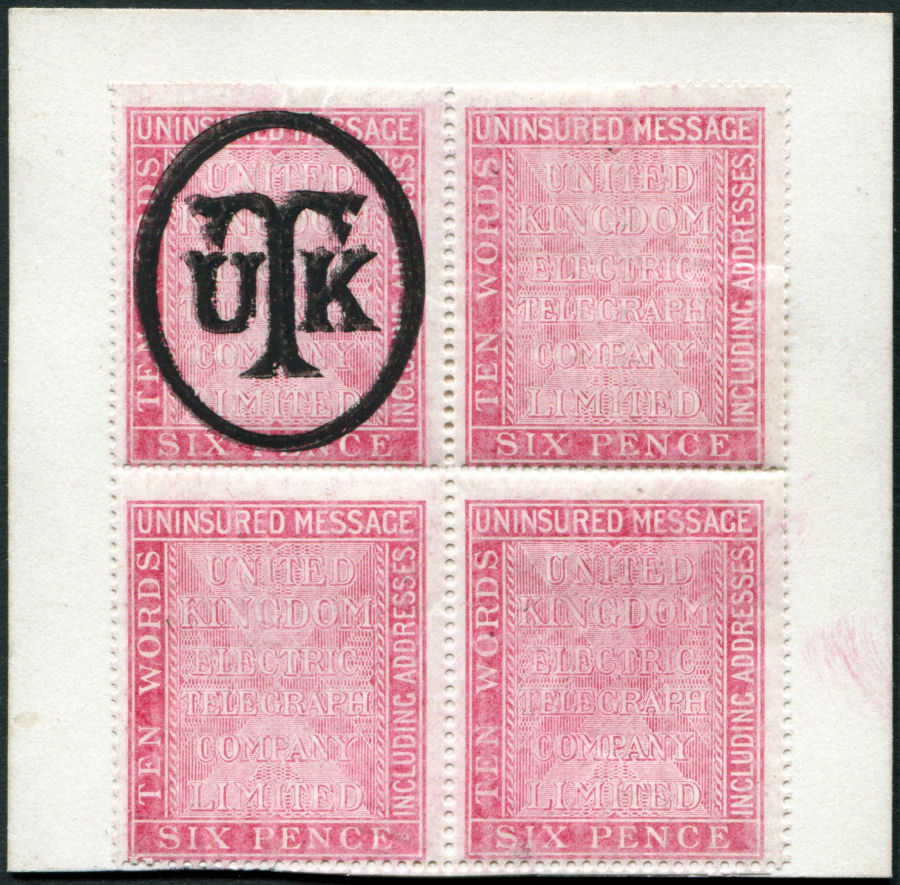
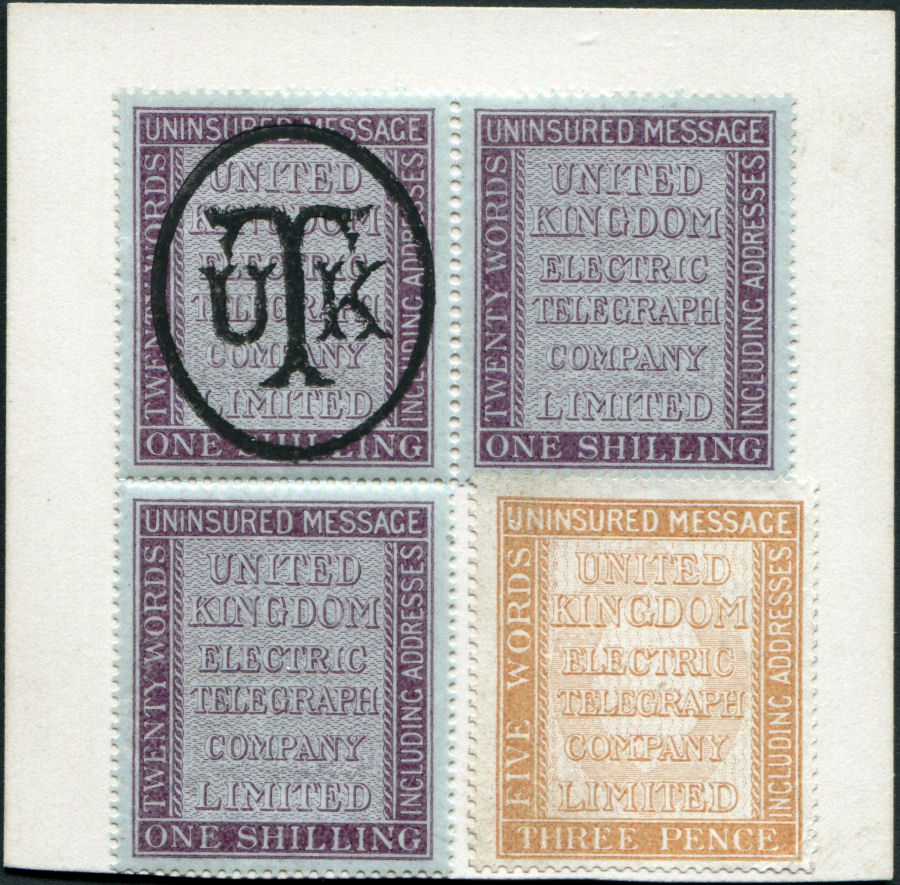
Images courtesy of Steve Lawrie.
Here are some examples of the cancel used.
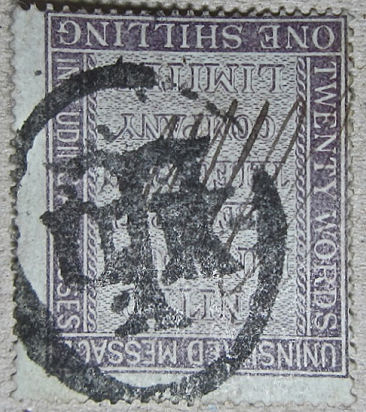 |
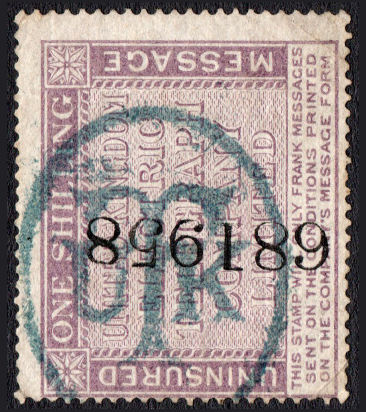 |
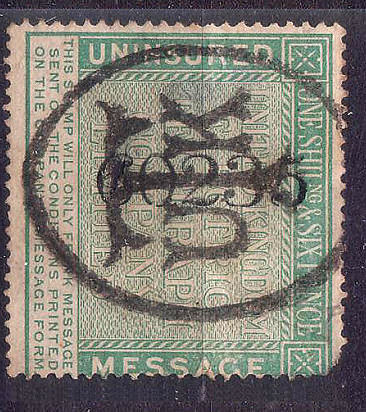 |
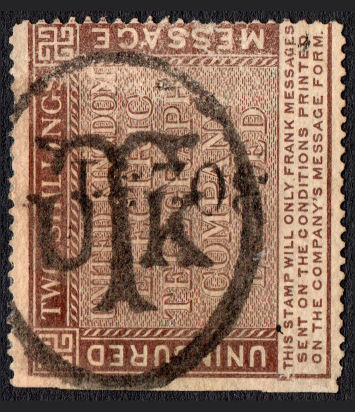 |
| RH4a used with black cancel and signature. | RH7 used with blue-black cancel. | RH9 60235 (lowest number) used with black cancel. | RH10 30231 used with black cancel. |
| Courtesy of Mark Gibson. | Images courtesy of Steve Lawrie. | ||
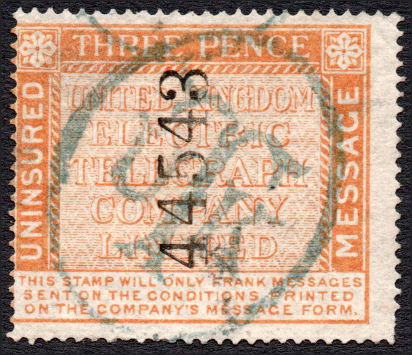 |
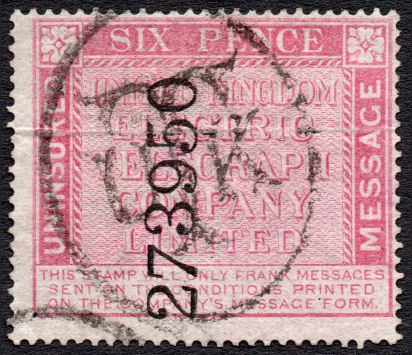 |
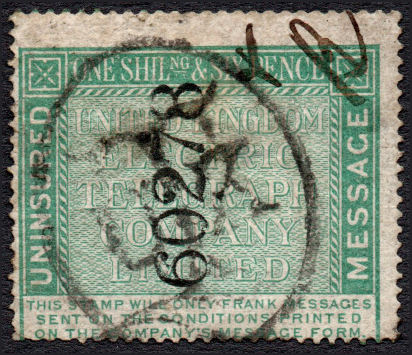 |
| RH5 - 3d-44543 used with blue-black cancel. | RH6a - slightly blued 6d-273950 used with black cancel. | RH9 - 1s6d-60278RH13 used with black cancel and initials. |
| Images courtesy of Steve Lawrie. | ||
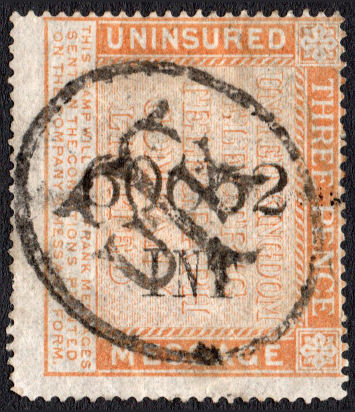 |
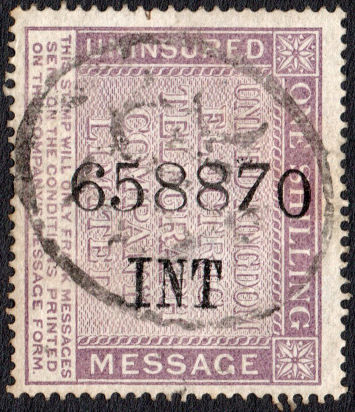 |
| RH11 used with black cancel. | RH13 used with blue-black cancel. |
| Images courtesy of Steve Lawrie. | |
Note, there are many variations of shades of ink and paper, personally I think the only thing worth paying a premium for on this issue is good centring!
As can be seen in the examples above, apparent shades are very much affected by the colour of the paper.
The carmine of the 6d looks very different on blued paper, and the green of the 1/6d stamps is different on yellowed paper. The 1/- was also variable.
On the subject of shades,
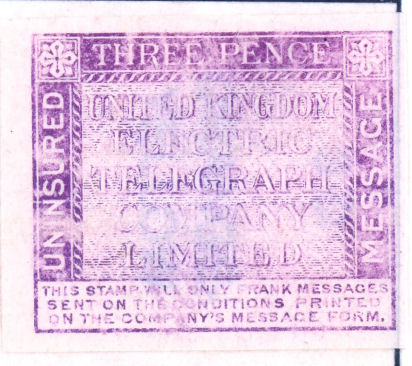
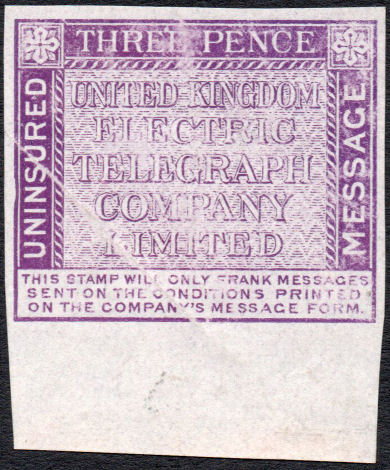
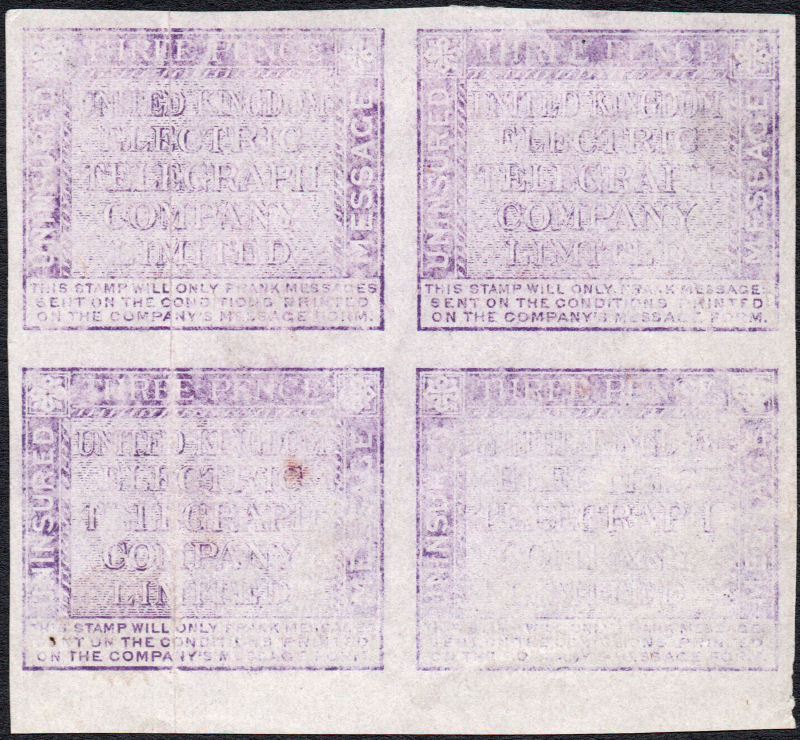
Fugitive examples, first courtesy of Mark Gibson, other two courtesy of Steve Lawrie.
According to L & H (bottom of Pg.31), since the 3d plate had little use, it was used by De La Rue after the Post Office takeover
to produce samples of their single and doubly fugitive inks. Also these are known in 6 colours as samples of their work.
According to Stanley Gibbons, this was for tendering for overseas business.
L & H also list(Pg.32) a number of other samples known from De La Rue archives.
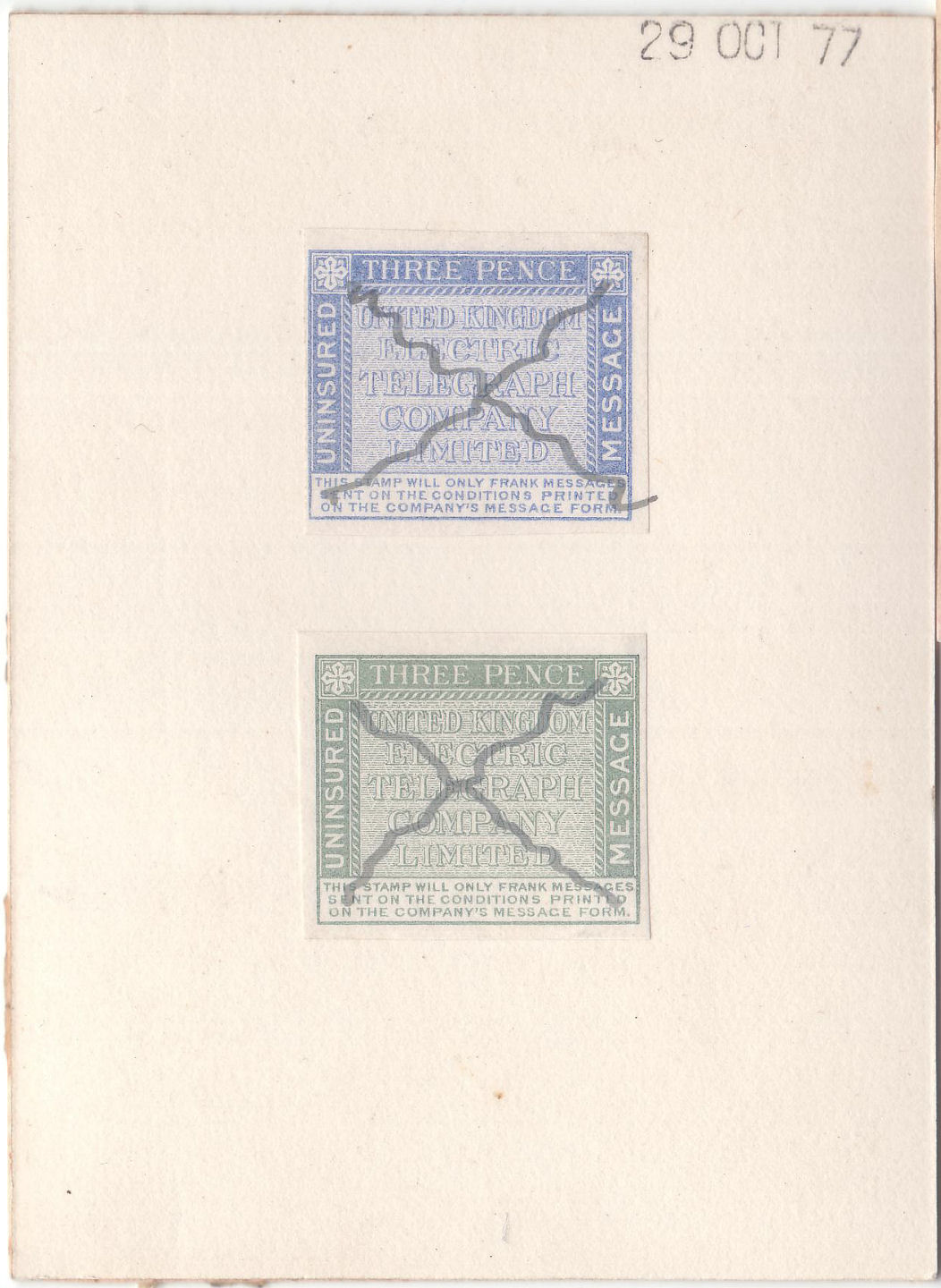
Doubly fugitive blue and green on card dated 29 October 1877. Image courtesy of Steve Lawrie.
L & H mention "a sheet with 12 examples of the scheme for the colours of the Mauritius Insurance,
Bills of Exchange, and Internal Revenue stamps dated 19 September 1878"
That would seem to relate to the following two pages shown (half size) courtesy of Steve Lawrie:
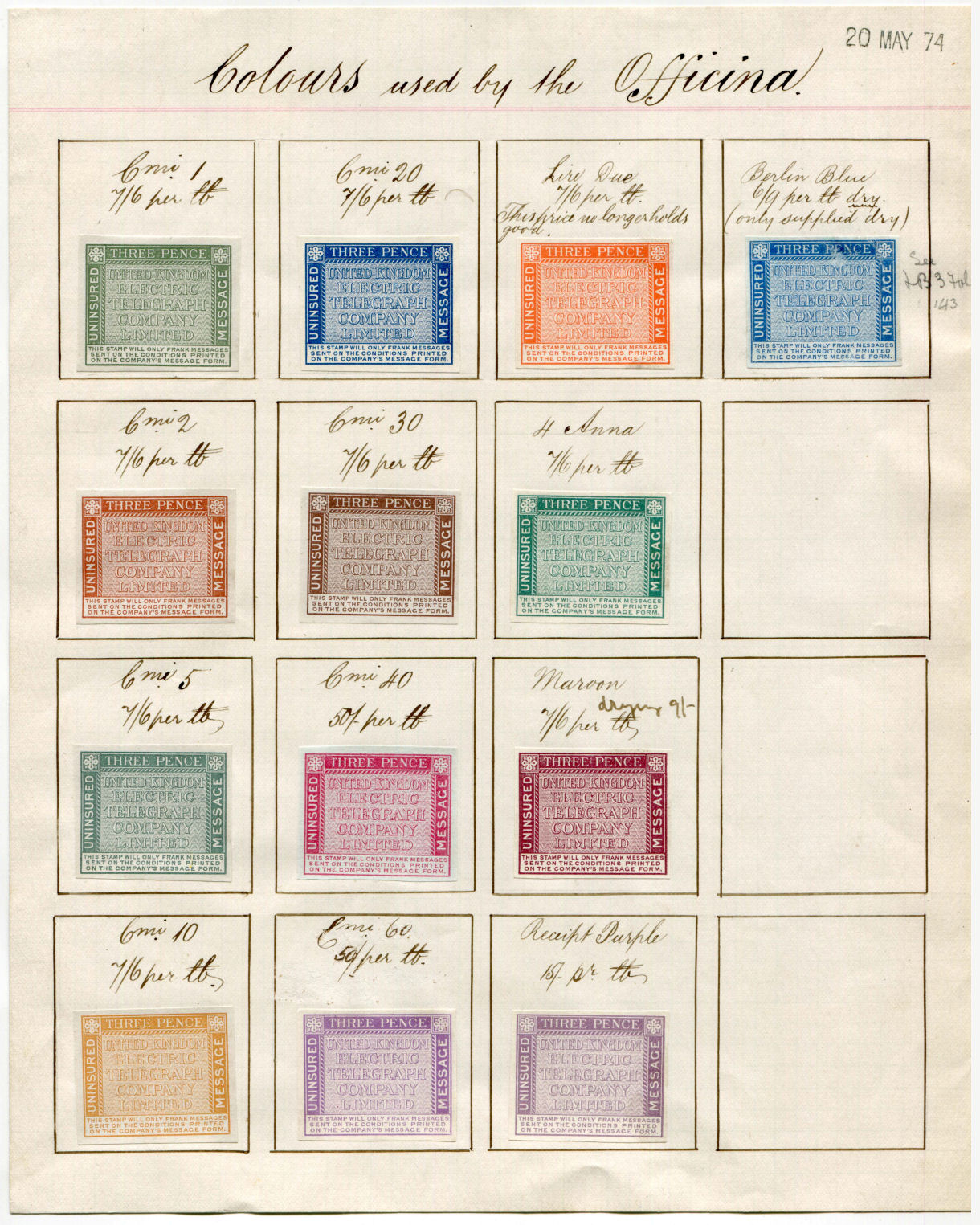
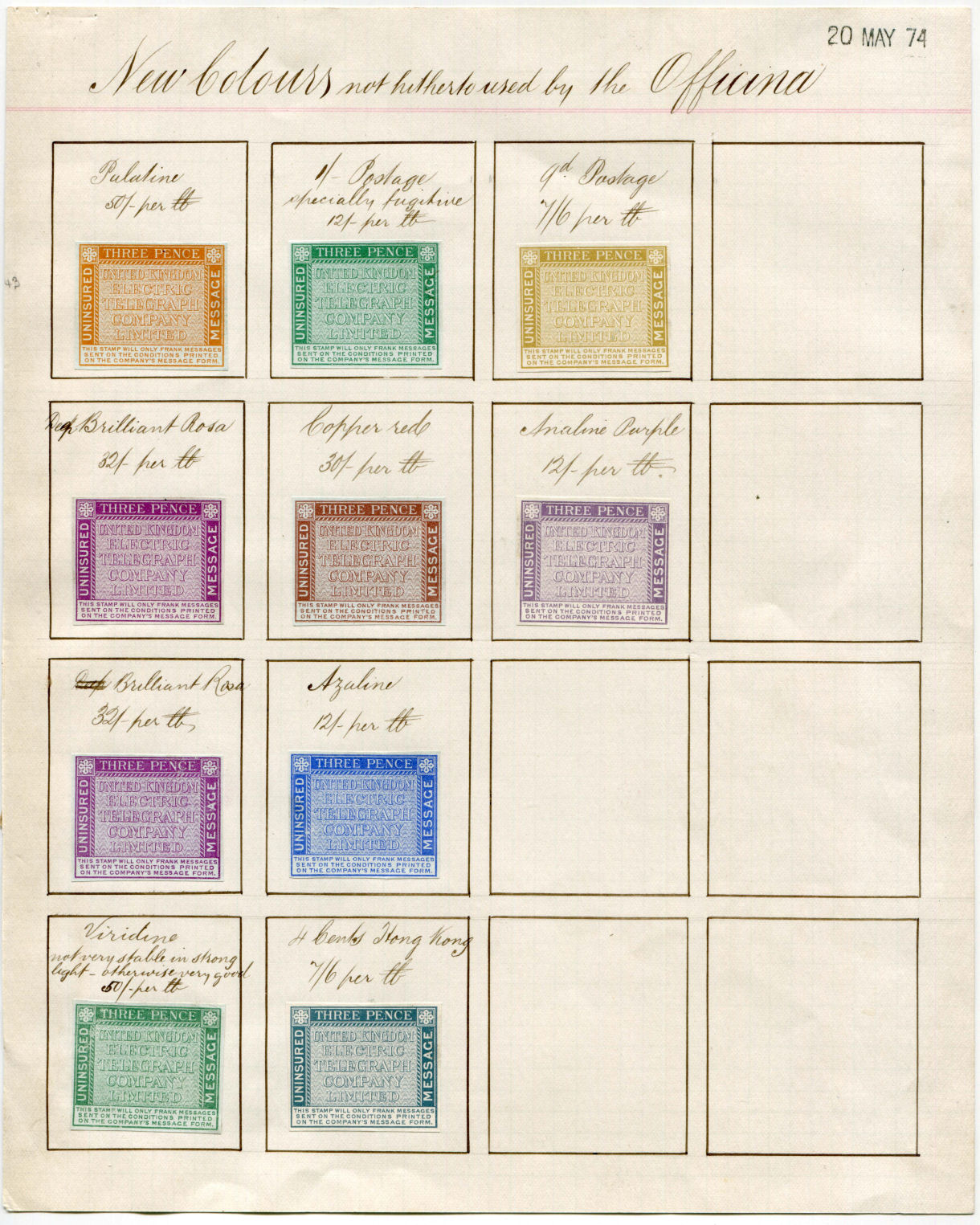
L & H next mention "a sheet with 23 different examples of ink colours" dated 20 May 1874, sent to the Italian Printing works in Turin.
That is almost certainly a reference to the following two pages, again shown (half size) courtesy of Steve Lawrie:
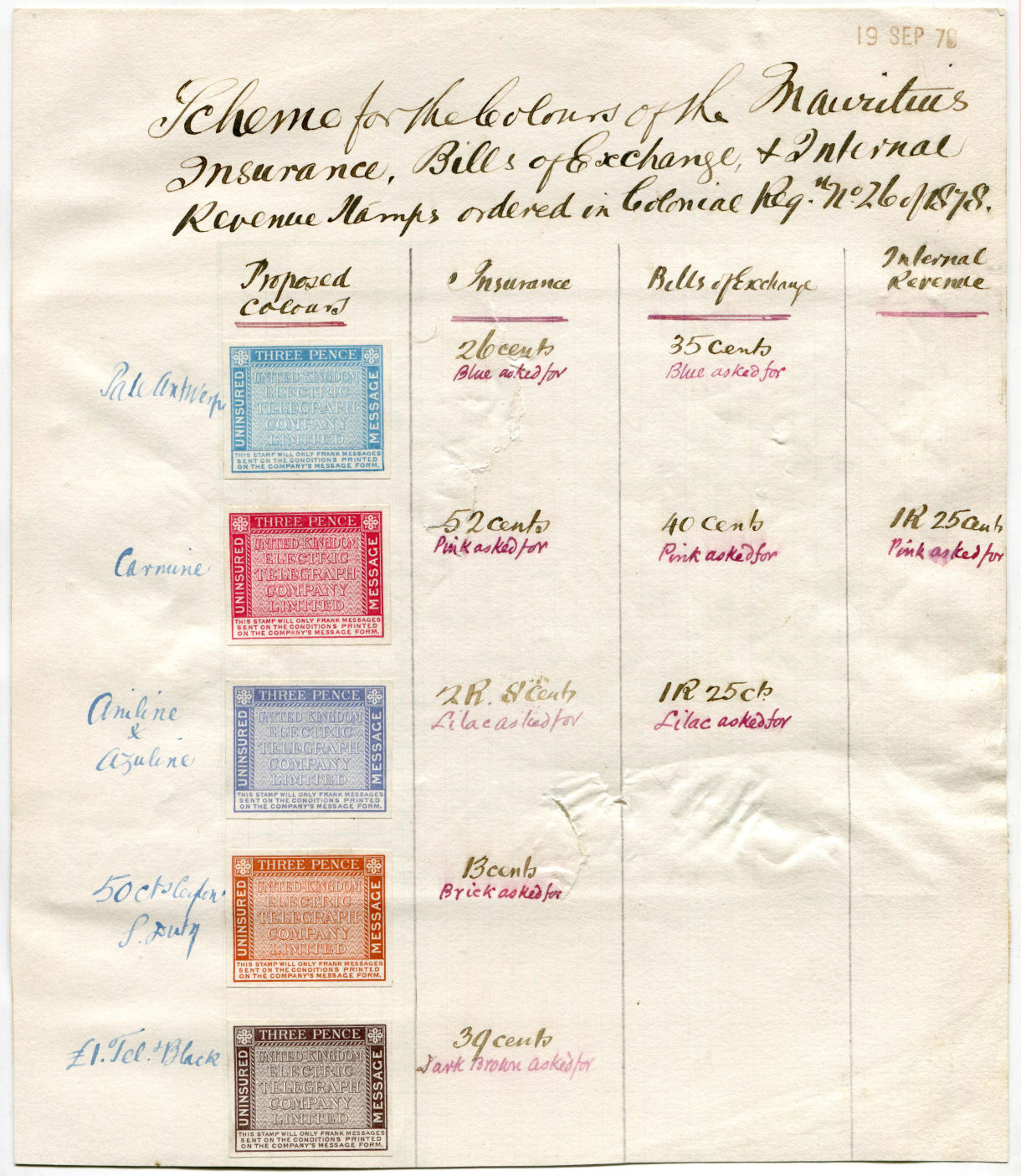
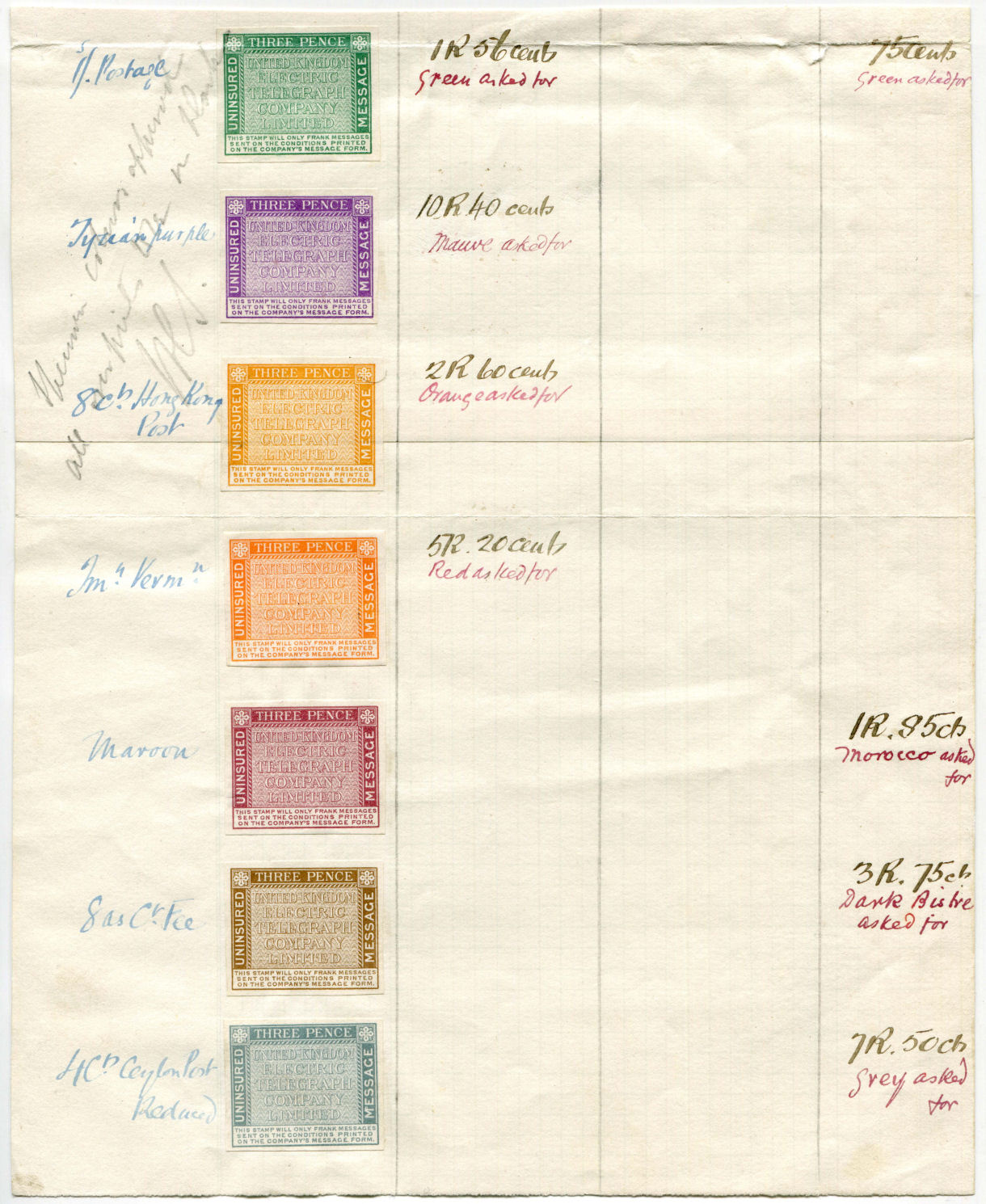
An additional couple of images, courtesy of Steve Lawrie, again half size.
These may relate to the next reference of L & H to six different colours and their Fig.49
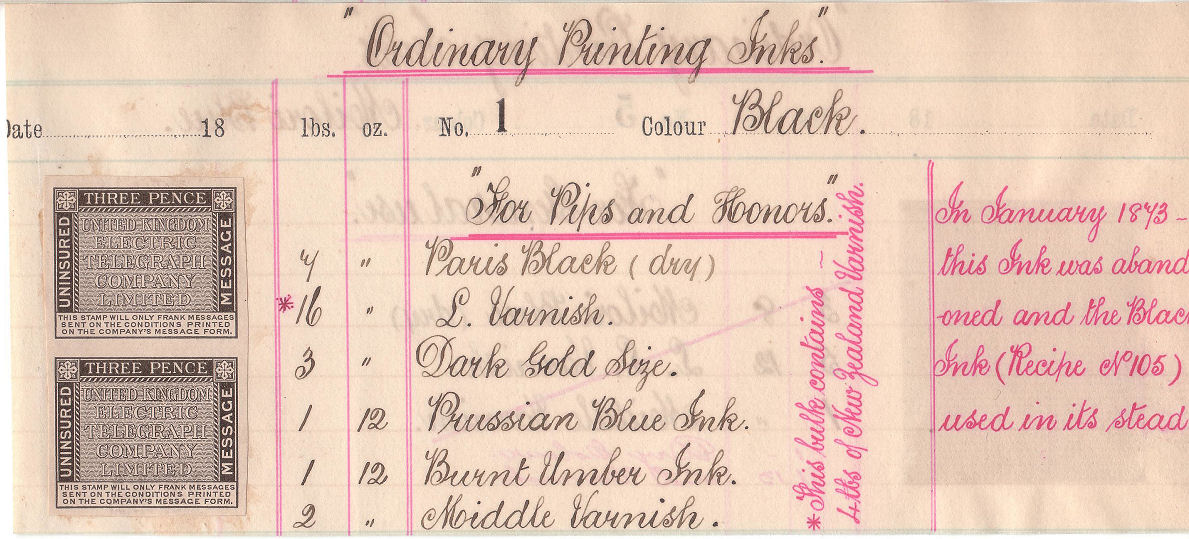
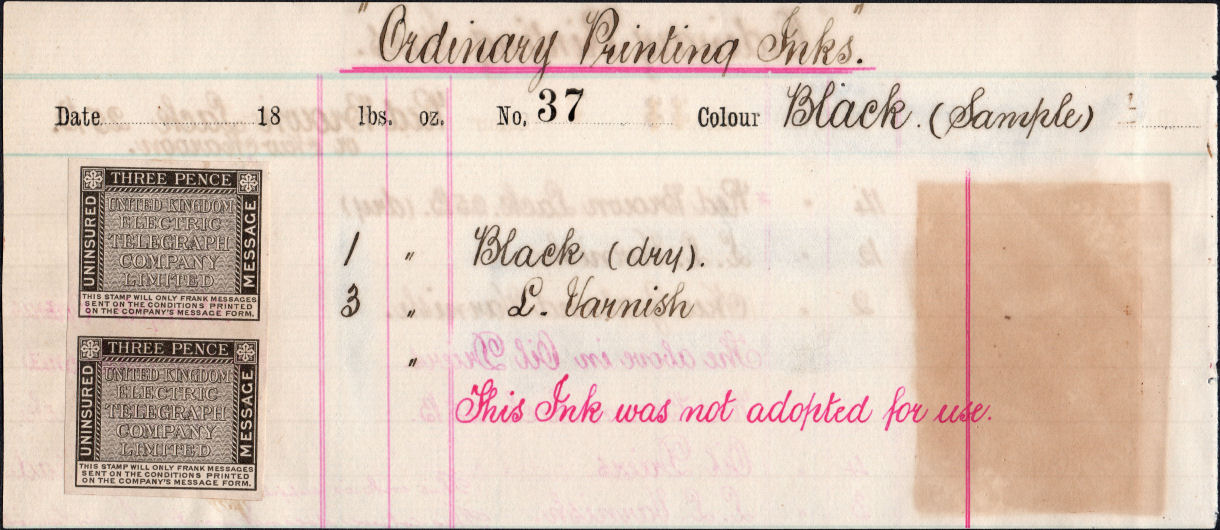
As can be seen, the colours they proposed did not always match well to the colours asked for.
| Links to UKET Forms. | |||||||
| Forwarding Forms (No.1) | Delivery Forms | Delivery Forms (2 a) | Delivery Forms [2 d] | Delivery Forms [3]? | Memorandum Forms [No.52.] | Envelopes | Receipts |
Forwarding Forms:
These were marked as '(No. 1.)' and there were at least two types printed by Tuck & Co. of 6 Union Court, Old Broad Street, London.
The differences lie in the number of London Offices listed. There appears to have been no space allocated for stamps.
Early type with 6 London Offices dated 24 March 1864, with 2/6d in vertical format, pen cancelled, 48 words. - My Ref. UKET-1-1864-1
Fancy border on the left. shown (half size) courtesy of Steve Lawrie:
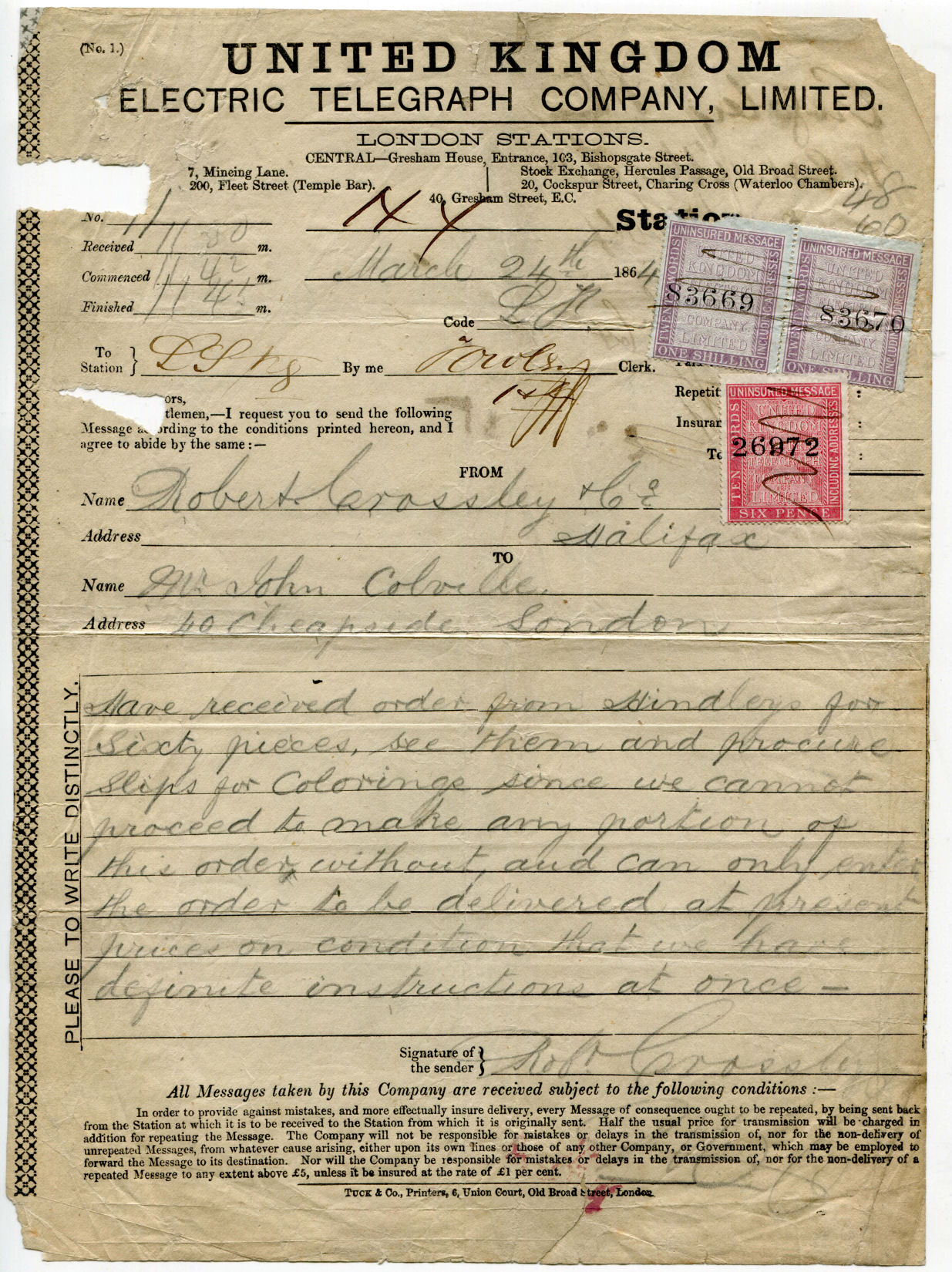
This was sent from Halifax 'HX' to Cheapside, London.
The printers imprint at the bottom reads "TUCK & Co., Printers, 6, Union Court, Old Broad Street, London."
Later type with 9 London Offices dated 22 October 1864, with 1/- horizontal format stamp (245035 type H7), blue UKT handstamp, 30 words. - My Ref. UKET-1-1864-2
shown (half size) courtesy of Steve Lawrie:
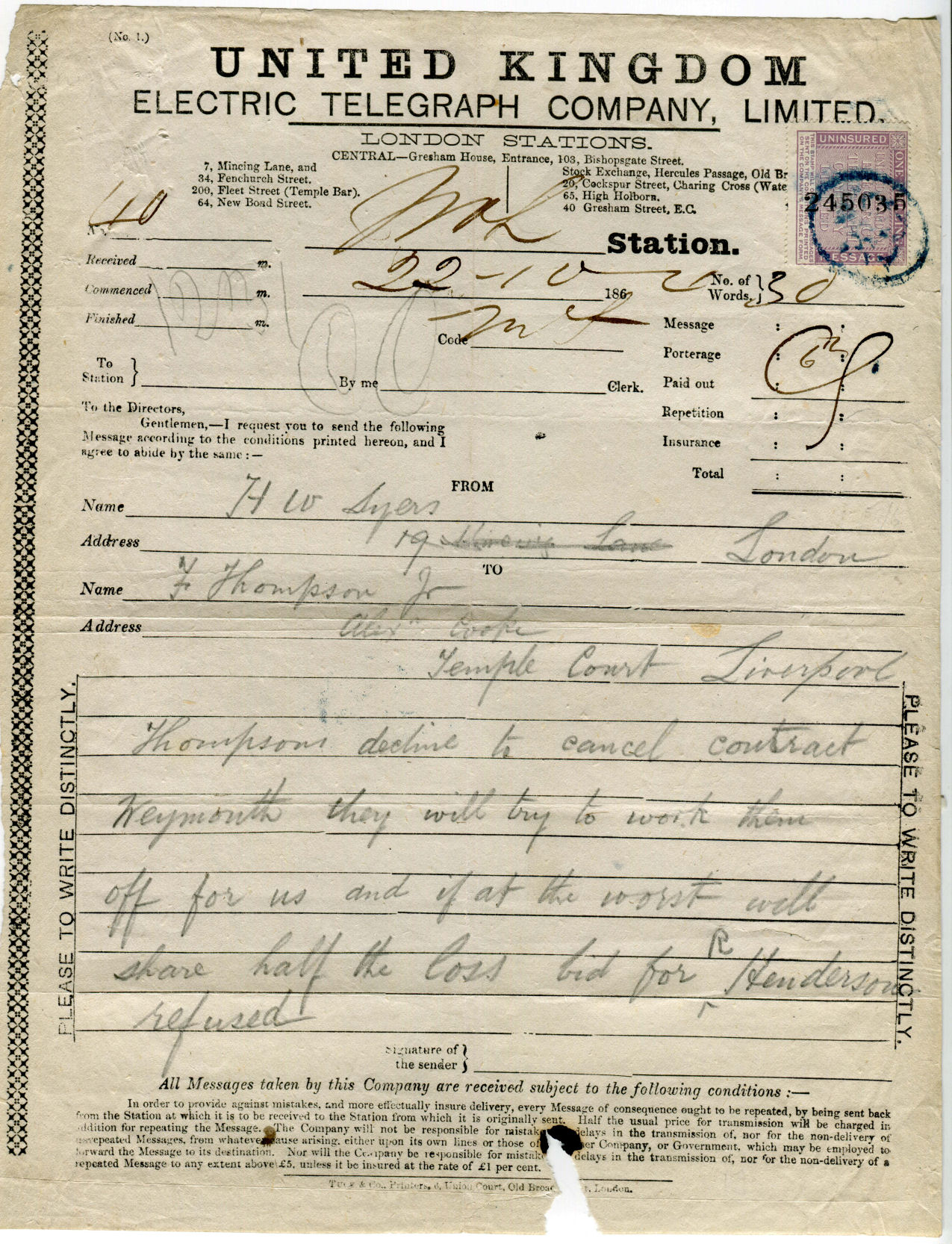
This was sent from Mincing Lane?, London to Liverpool.
Later type without the fancy border but still with 9 London Offices, this dated 12 April 1864, with 2 x 6d vertical format stamps, circular handstamp, 20? words. - My Ref. UKET-1-1864-3
shown (half size) courtesy of Steve Lawrie:
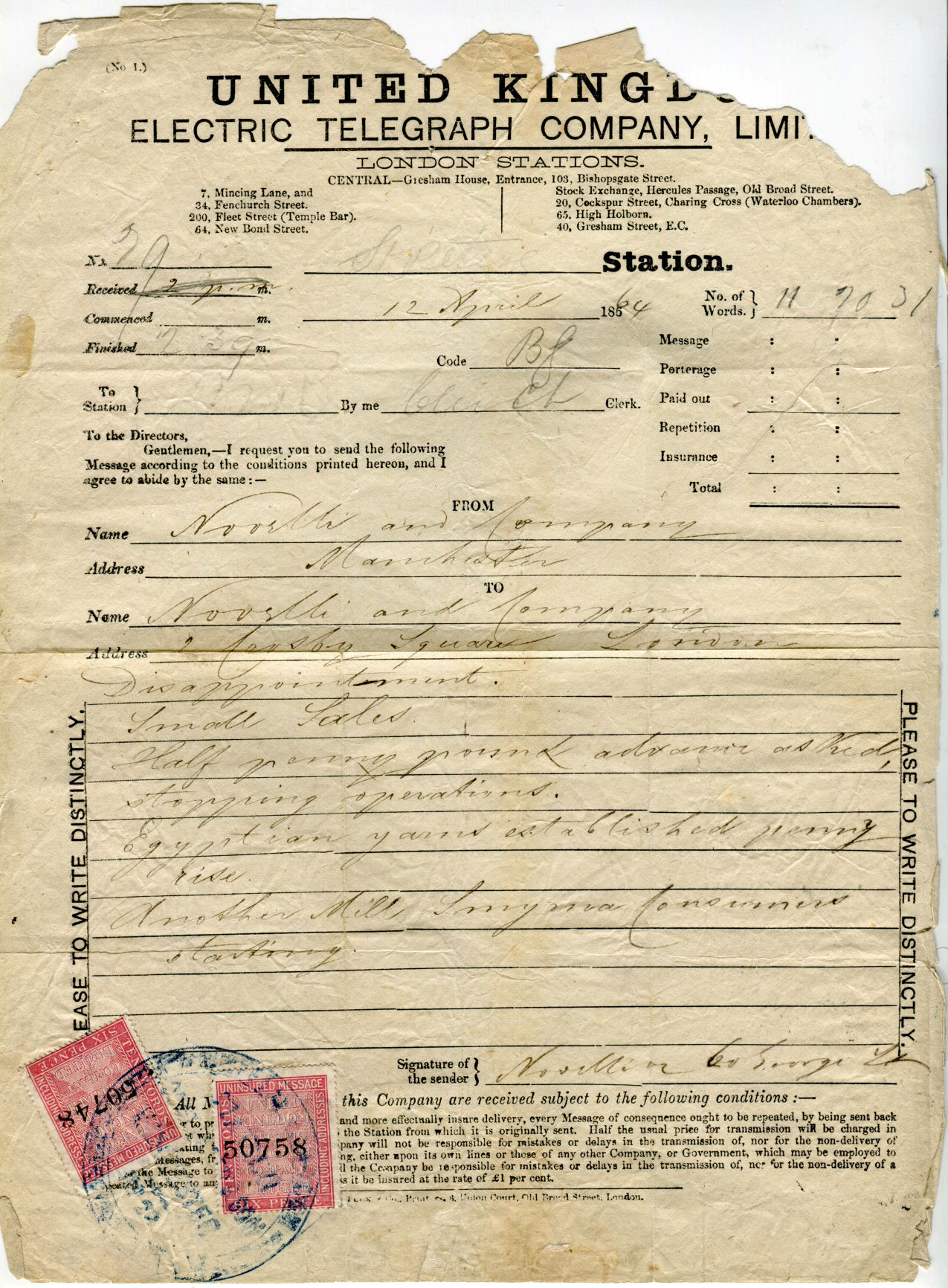
This was sent from St. Peters, Manchester to London.
Later type with 11 London Offices, this has not been completed and has no stamps, you would think it was not sent. - My Ref. UKET-1-1867-1
At the bottom though it says "Sent April 2/67 12 o' clock Noon from head office in London". Shown (half size) courtesy of Steve Lawrie:
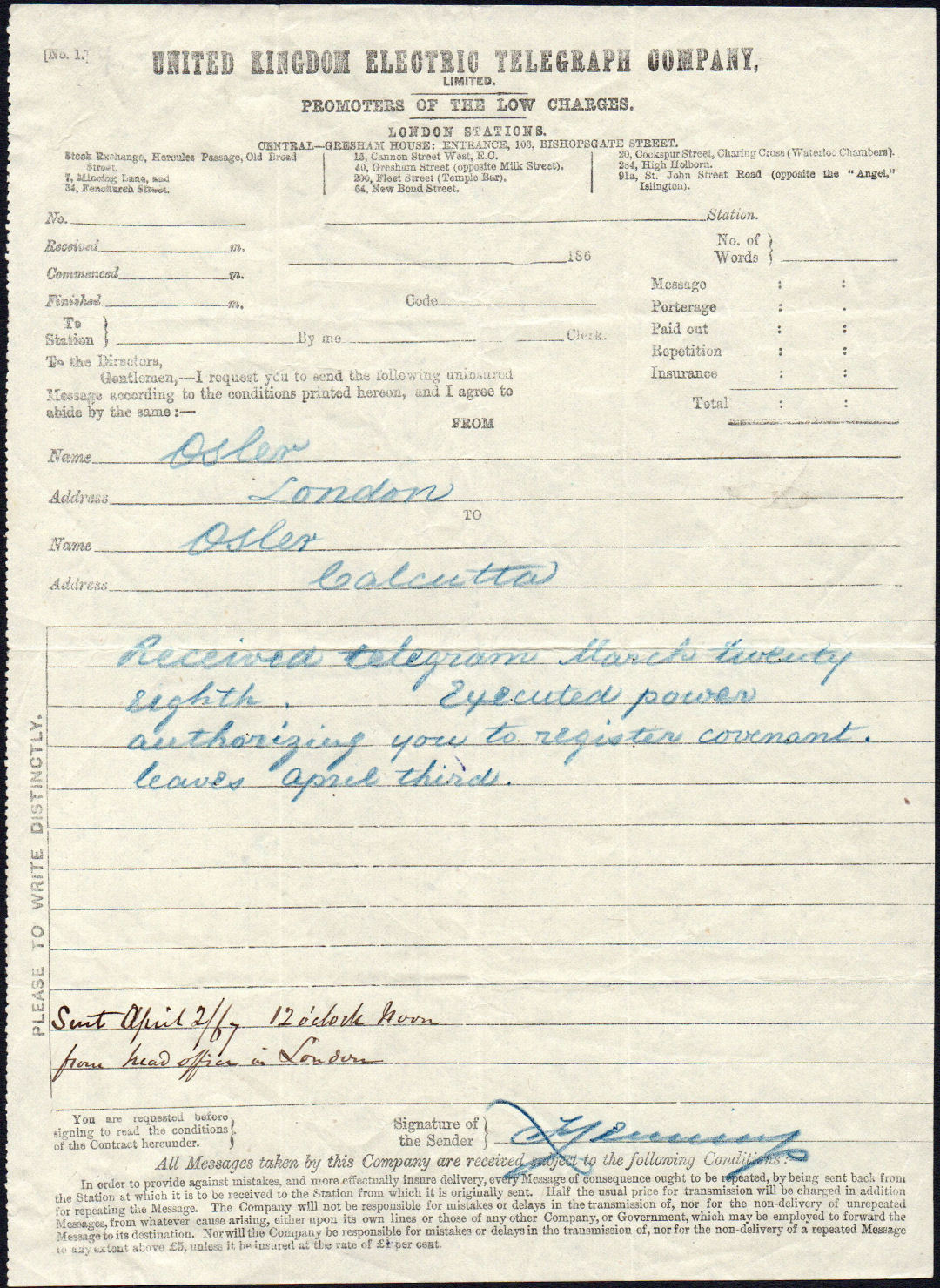
Perforated on the left, so presumably torn from a pad. This has no printers imprint.
A Later type again, now with 11 (different) London Offices. Like the last, this has not been completed and has no stamps. - My Ref. UKET-1-1869-1
On the back though it says "Copy 26 October 1869", which probably explains it being incomplete. Perhaps the one above was also just a copy.
Shown (half size) courtesy of Edward Coombes.
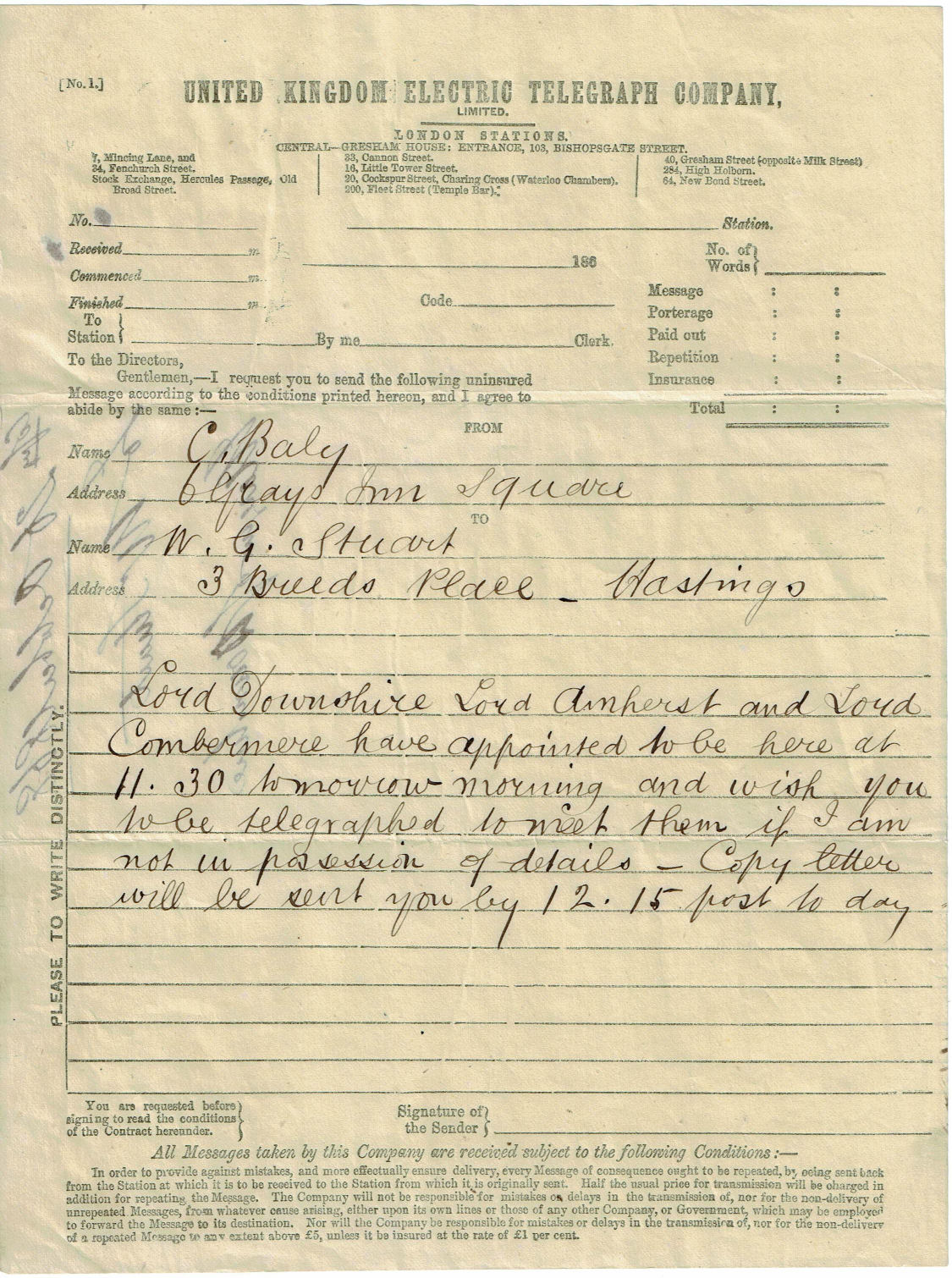
This has no printers imprint, and nothing printed on the back - size 189 x 252 mm.
Forwarding Form listing.
| Provisional Reference | Form number | Date on form | Dates used | Size mm. | London Offices | Other UK Mainland | Printer | Comments |
|---|---|---|---|---|---|---|---|---|
| UKET-1-1864-1 | 1 | 186_ | 24/3/1864 | ???? | 6 | - | Tuck & Co. | fancy border on left |
| UKET-1-1864-2 | 1 | 186_ | 22/10/1864 | ???? | 9 | - | Tuck & Co. | fancy border on left |
| UKET-1-1864-3 | 1 | 186_ | 12/4/1864 | ???? | 9 | - | Tuck & Co. | fancy border gone |
| UKET-1-1867-1 | 1 | 186_ | 2/4/1867 | ???? | 11 | - | "Promoters of the low charges" | |
| UKET-1-1869-1 | 1 | 186_ | 26/10/1869 | ???? | 11 | - | London addresses changed |
Delivery Forms:
Early ones had no form number. Later they were marked as '(2 a)' or '[2 d]' and there may have been others.
There are differences in the number of London and Provincial Offices listed.
Form dated 22 November 1861. Bare essentials only. - My Ref. UKET-1861-1
Sent from Liverpool, received at 20 Cockspur Street Station, London. Image courtesy of Mark Gibson:
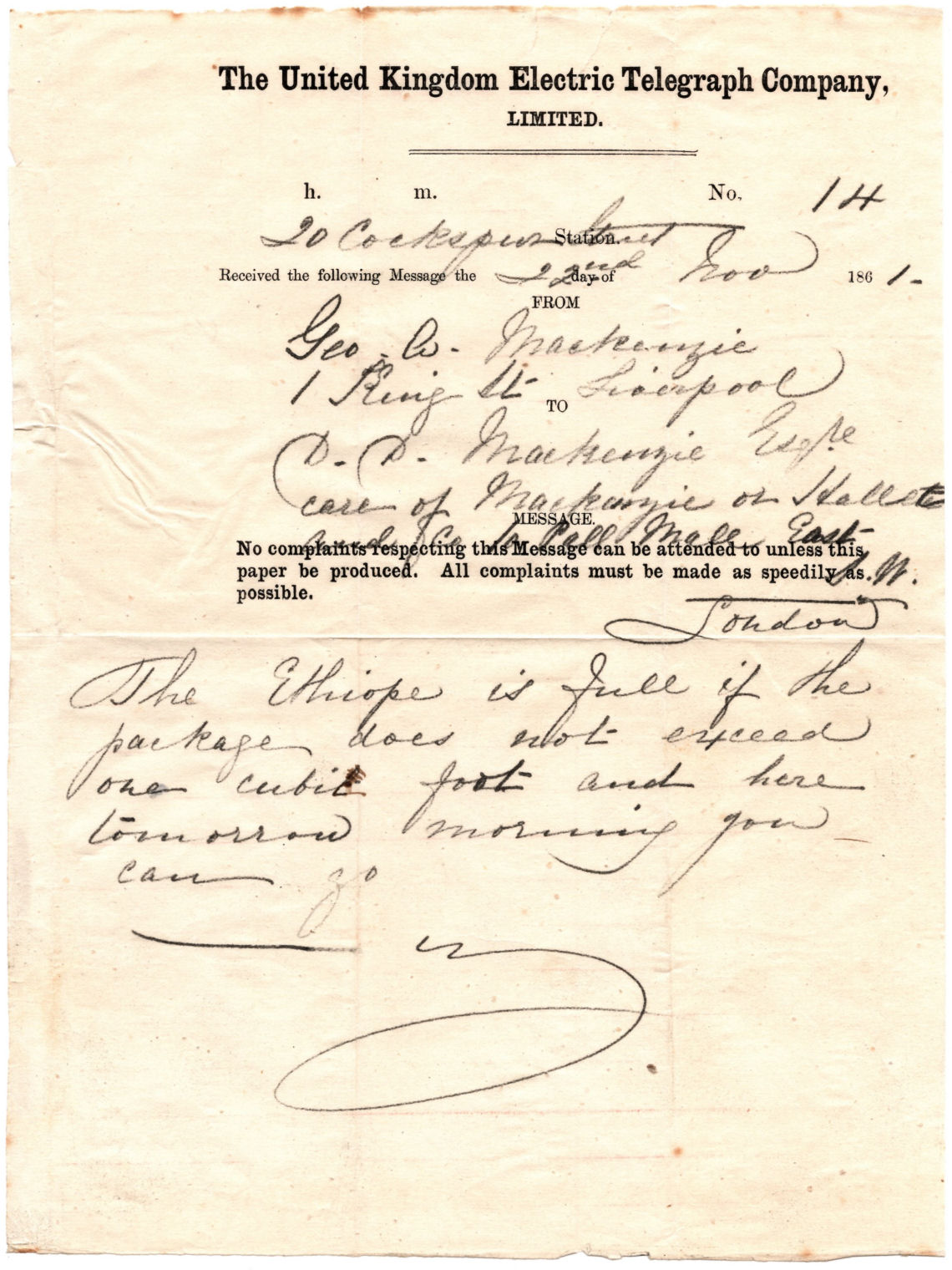
No receiving stamp of any kind.
Code (2a) form dated 19 November 1864 lists 'Stations now open' giving 6 in London and 16 throughout the rest of the country. - My Ref. UKET-2a-1864-1
Image courtesy of Mark Gibson:
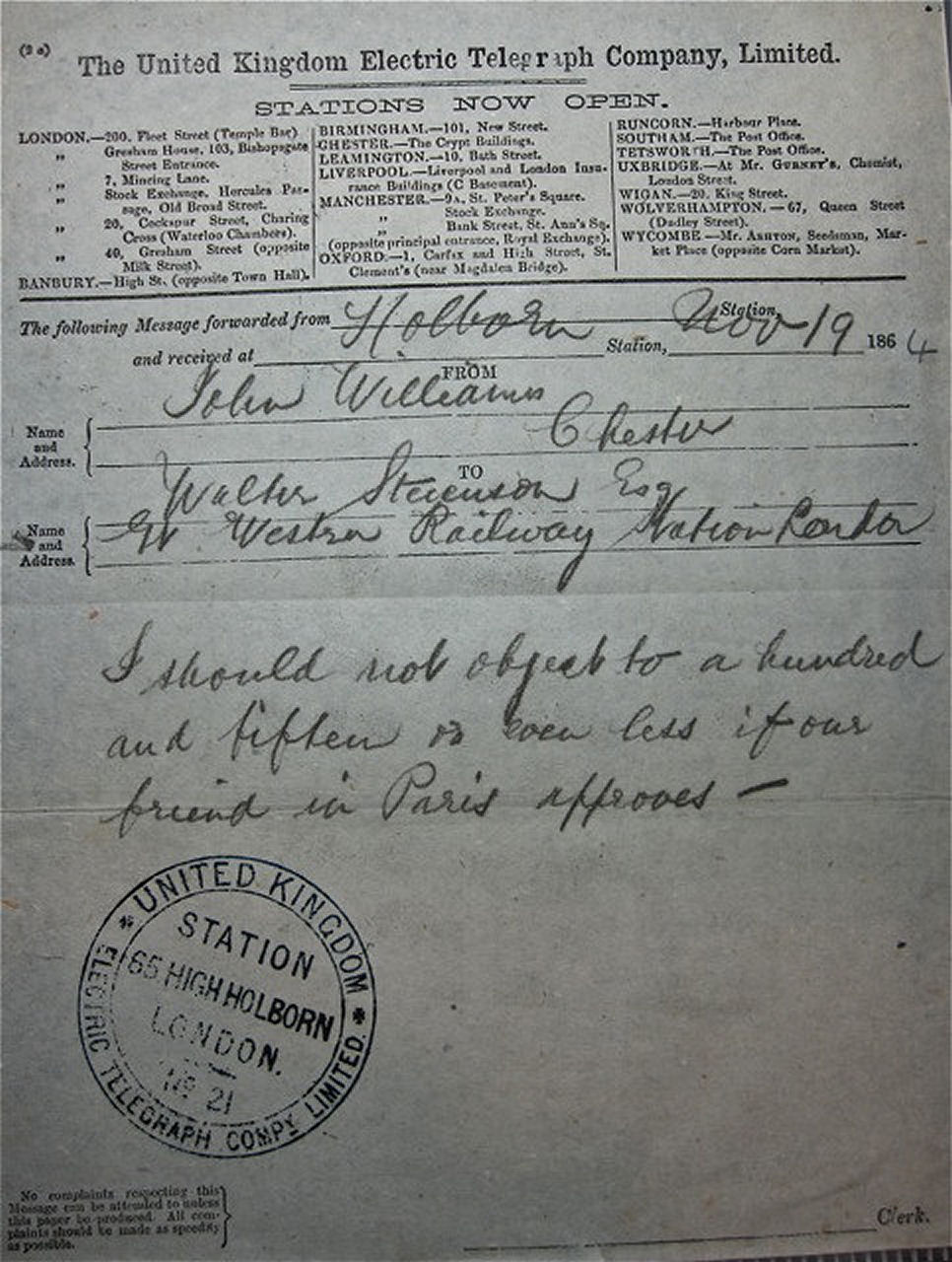
It is stamped with a circular cachet for 65 High Holborn, London at the bottom. From about 1866, this changed to 234 High Holborn.
A later Code (2a) form dated 25 March 1865 lists only 'Chief Stations now open' giving 8 in London (adding 65 High Holborn and 64 New Bond Street) and - My Ref. UKET-2a-1865-1
20 others throughout the rest of the country. Size 182 x 247 mm. - Image courtesy of Edward Coombes:
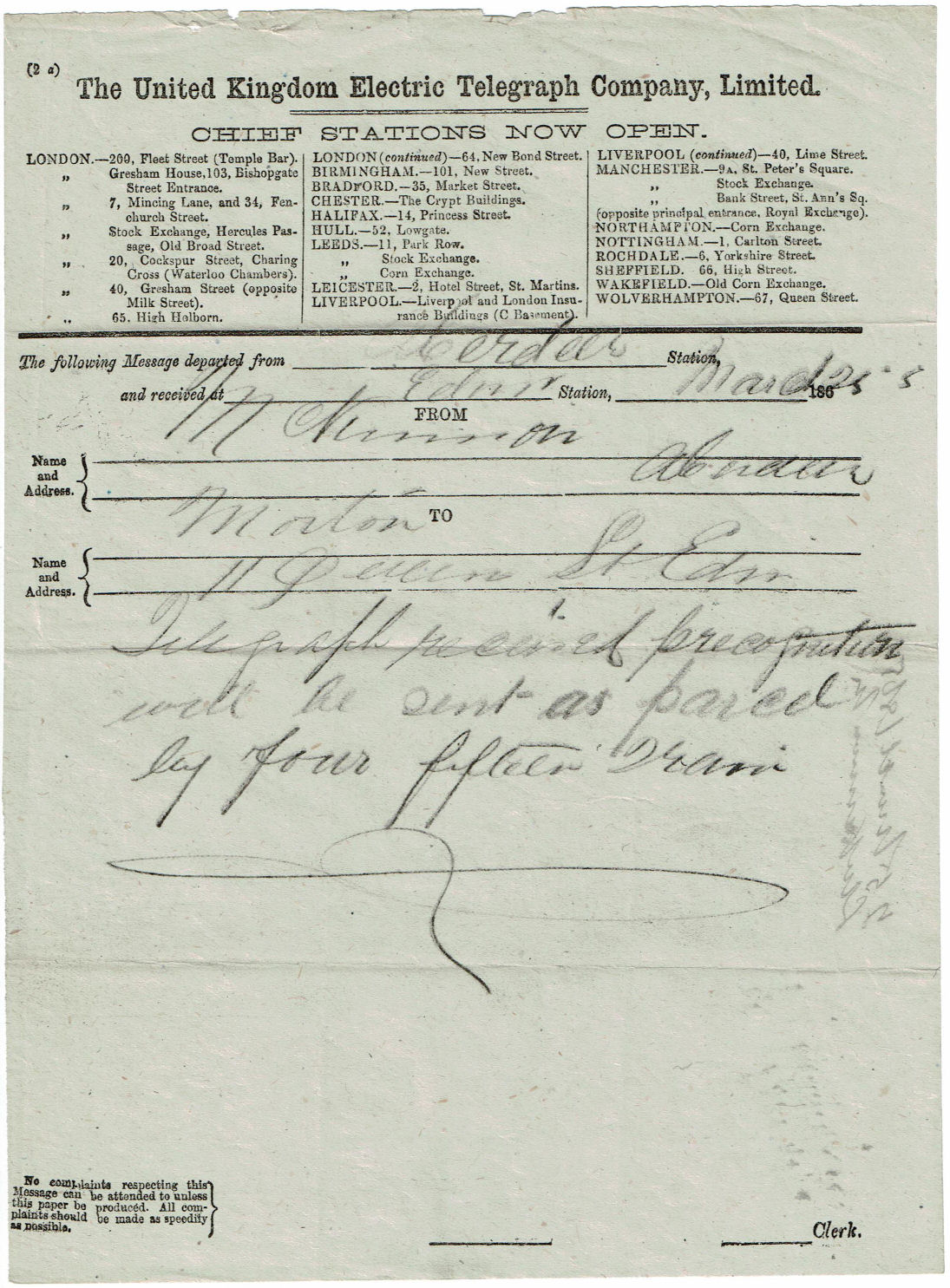
It is from Aberdeen to Edinburgh (neither of which is on the list of Chief Stations then, but see below).
Code [2d] form dated 27 November 1864 lists 'Chief Stations now open' giving 8 in London and 24 throughout the rest of the country. - My Ref. UKET-2d-1864-1
Scotland and Wales are now on that list. - Image courtesy of Steve Lawrie:
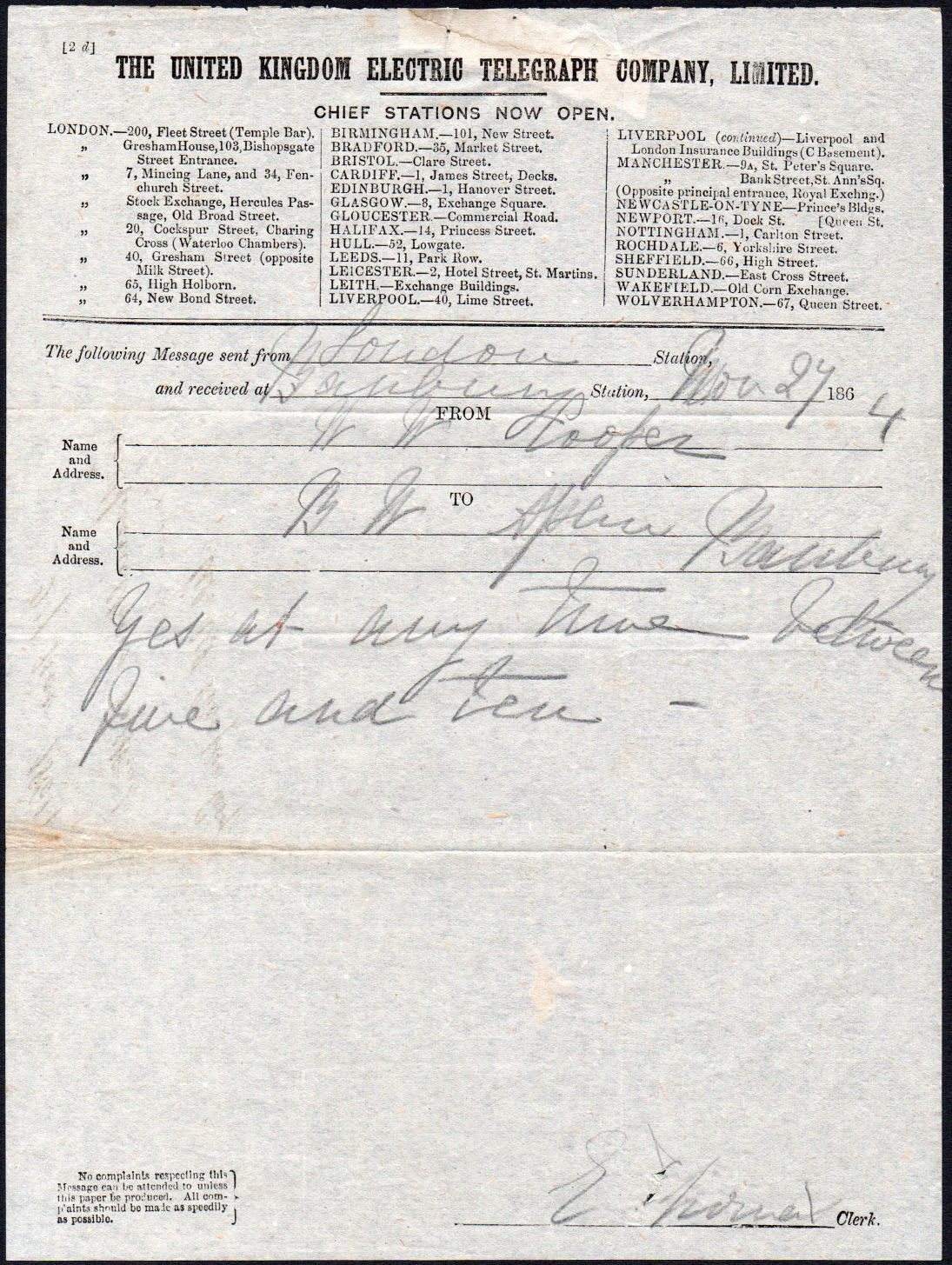
Code [2d] form. The year is unclear on this, but The list of Stations matches the one above. I include it to show the 'BRADFORD STATION' cachet. - My Ref. UKET-2d-1864-1
Size 185 x 244 mm - Image courtesy of Edward Coombes.
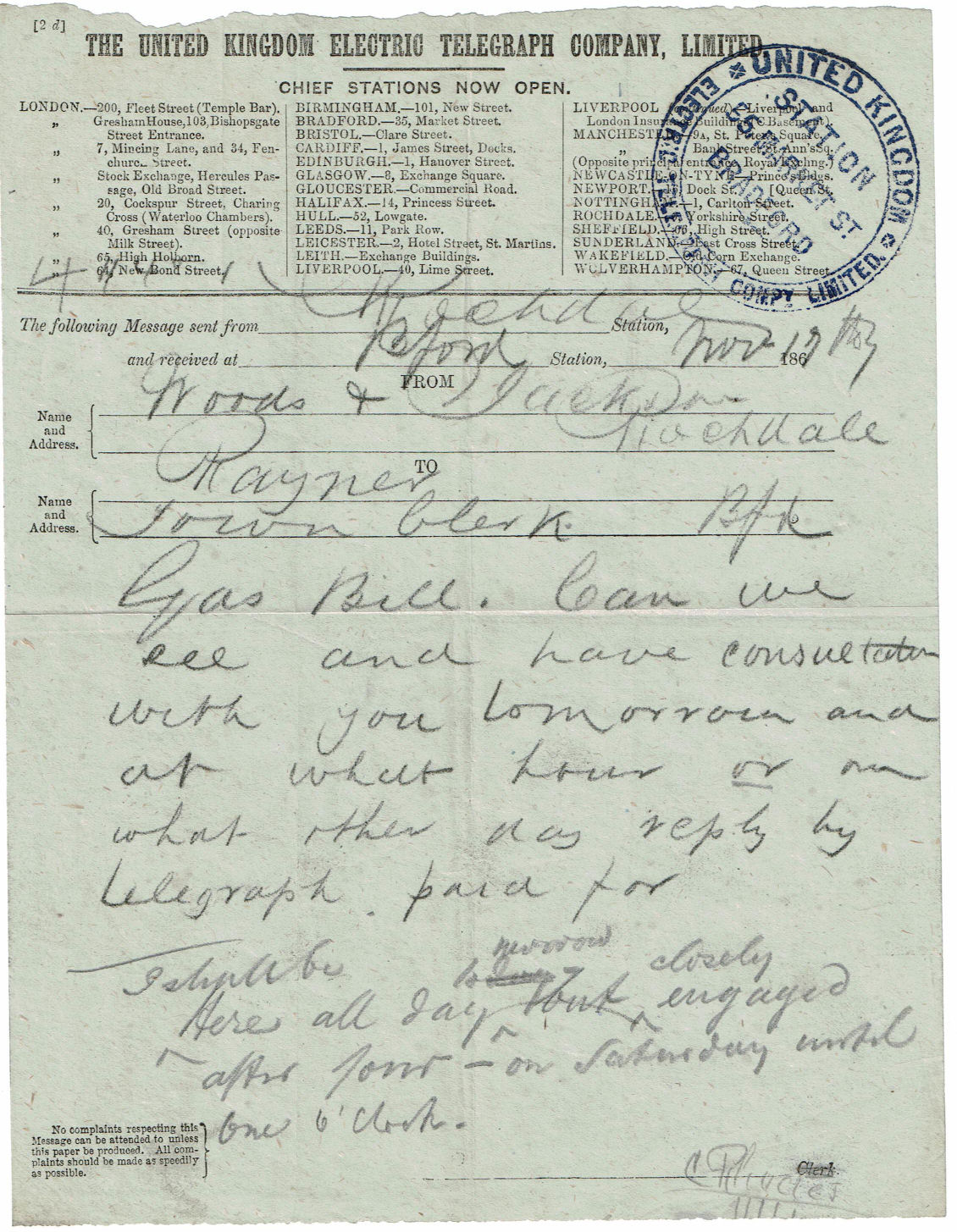
Code [2d] form dated 31 September 1865 proclaims the UK Electric Telegraph Company as 'Promoters of the Uniform Shilling Charge for Telegrams, irrespective of distance.' - My Ref. UKET-2d-1865-1
This stance was unpopular with its' competitors who matched them in competitive areas while continuing with higher rates elsewhere.
It lists now only 'Chief Stations now open' and has 8 in London, with 32 elsewhere.
Image courtesy of Mark Gibson:
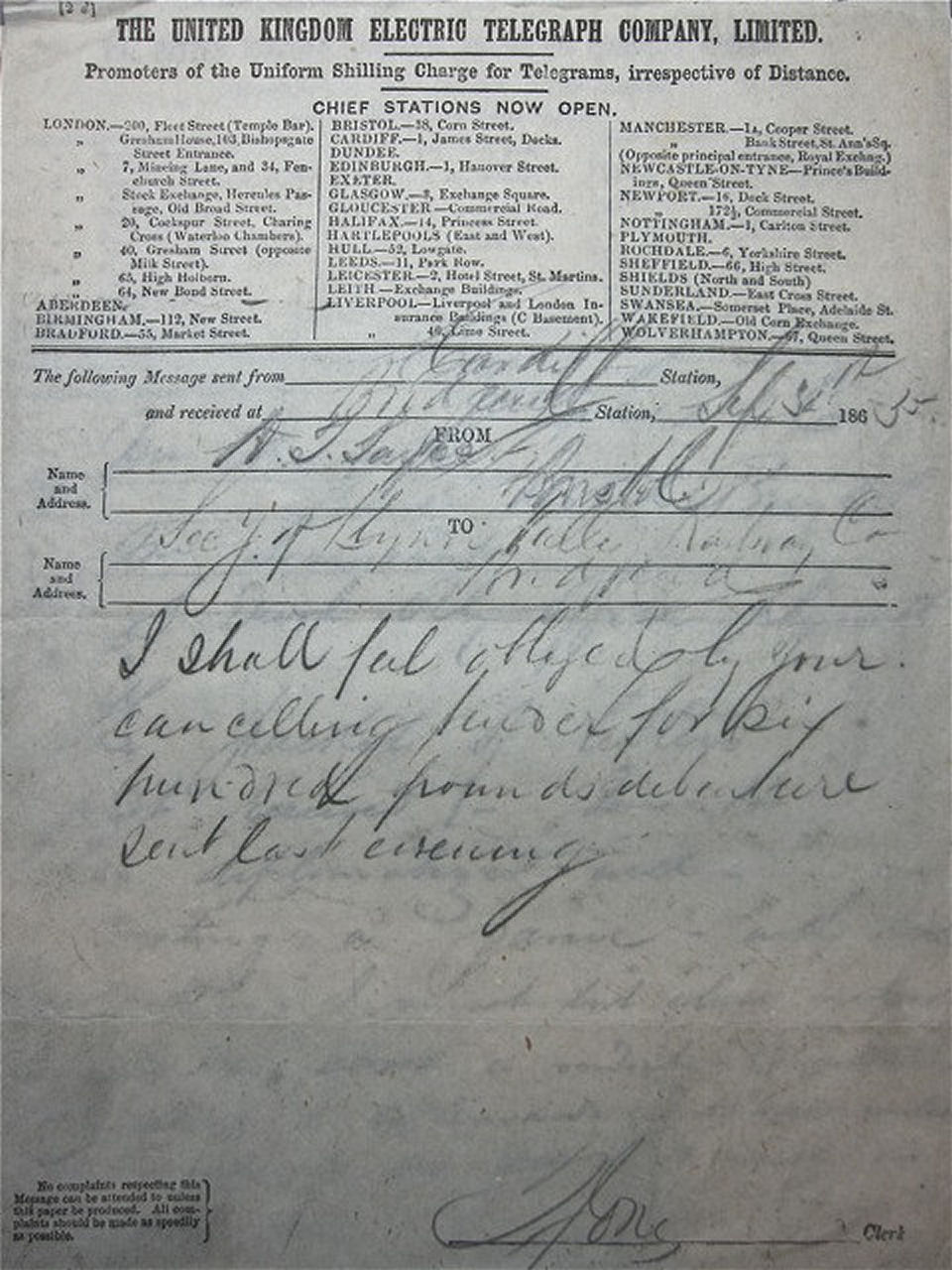
Code [2d] form dated 30 October 1866. The list of Stations is the same (8 / 32), but the claim is now 'Promoters of Cheap Telegrams.' A move towards compromise. - My Ref. UKET-2d-1866-1
Also the High Holborn address has changed from 65 to 234. Size 183 x 245 mm - Image courtesy of Edward Coombes.
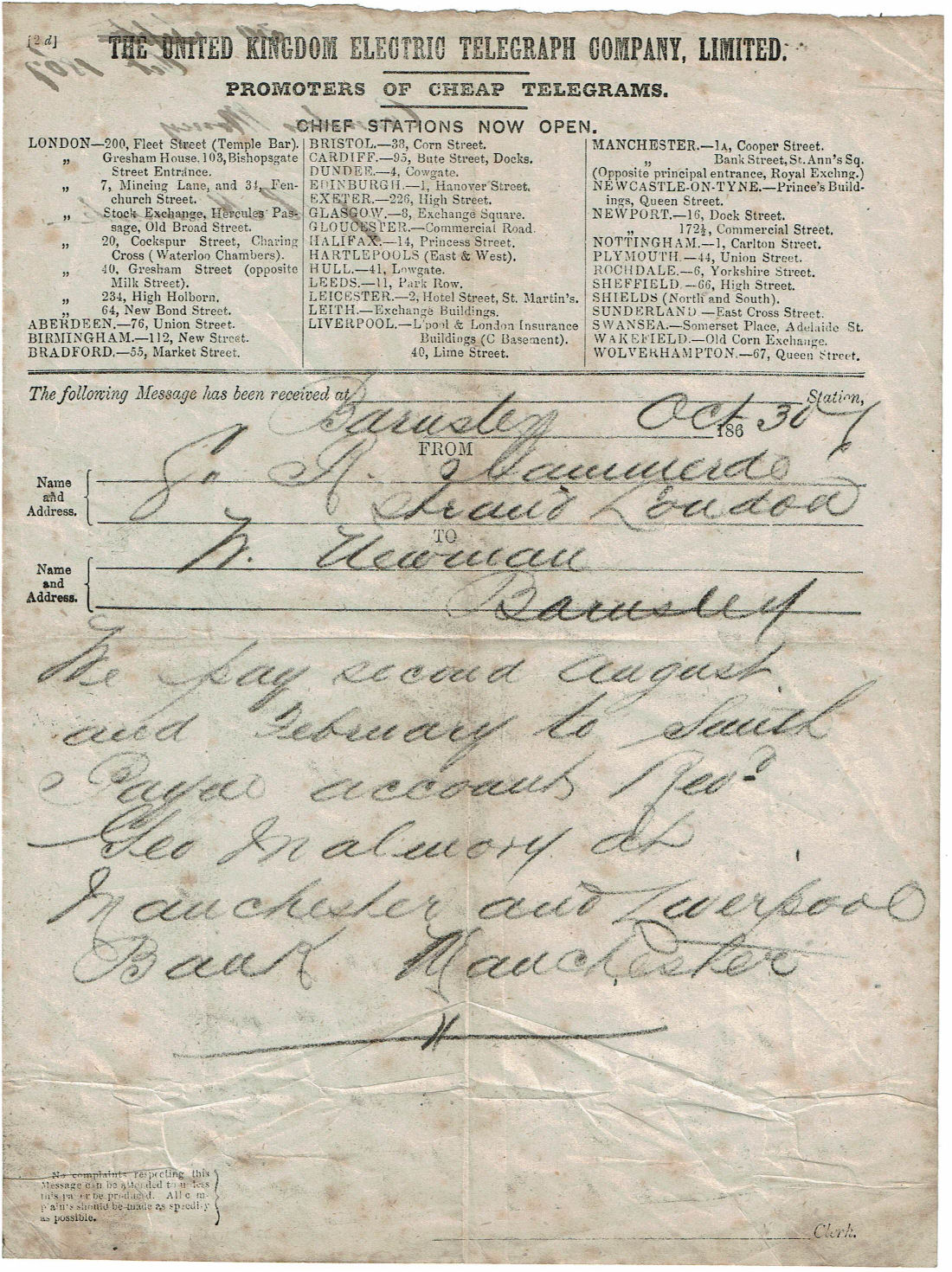
Another code [2d] form, dated 22 August 1869, now with 4 columns of Chief Stations and no reference to Uniform or Cheap prices. - My Ref. UKET-2d-1869-1
It has 10 in London and 43 in the rest of the country. - Image courtesy of Edward Coombes (Ex. Steve Lawrie)
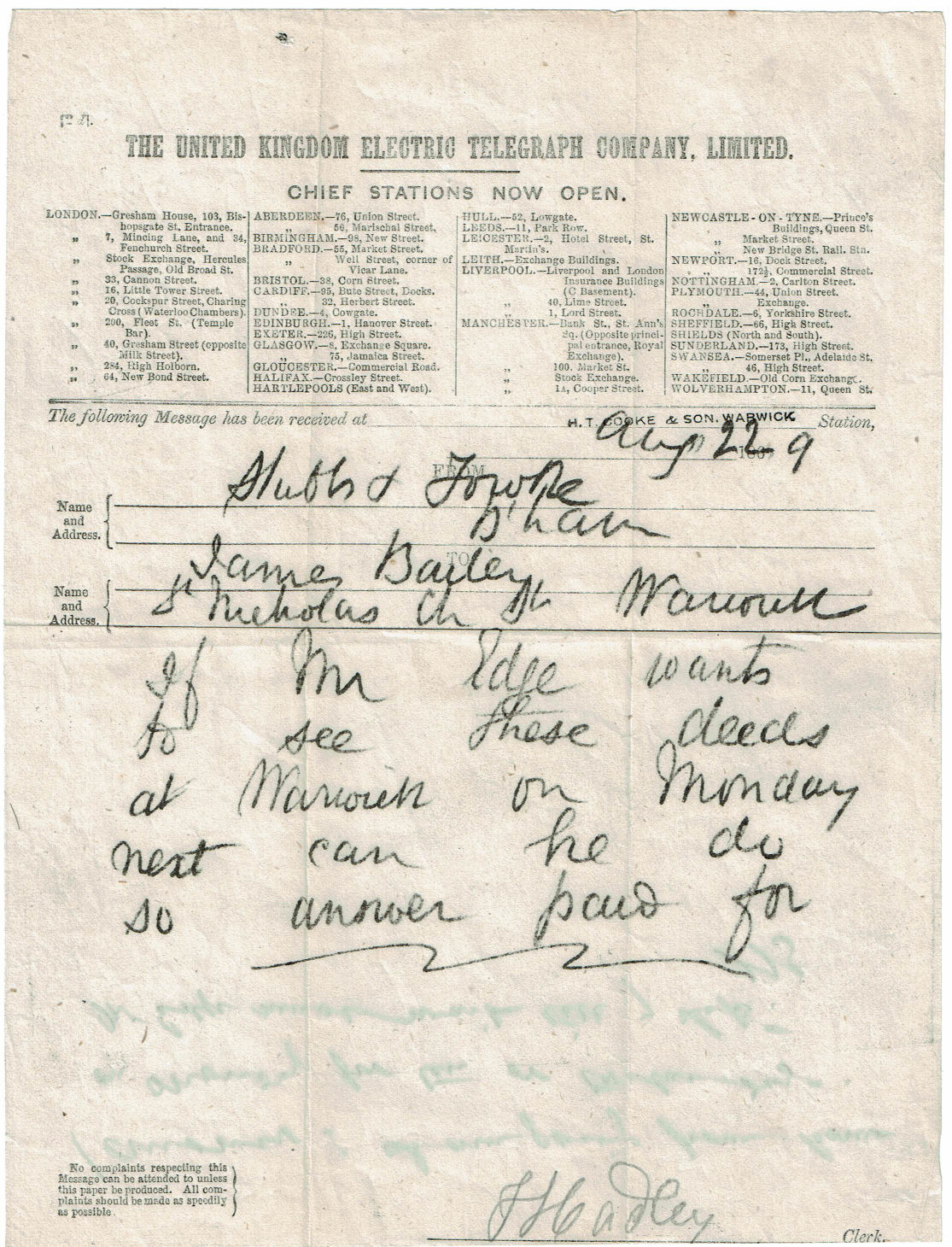
This was from Birmingham to James Bailey, and received at H. T. COOKE & SON, WARWICK Station !
There is an envelope shown below with a cachet of this company,
to a Bailey with a date exactly 1 year earlier and a different address.
Note the "answer paid for". An answer can be seen on the back showing through the front.
A new code [3] ? form, dated 7 August 1867, with 4 columns of Chief Stations and no reference to Uniform or Cheap prices. - My Ref. UKET-3?-1867-1
It has 10 (different) in London and 37 in the rest of the country. - Image courtesy of Jim Hammond.
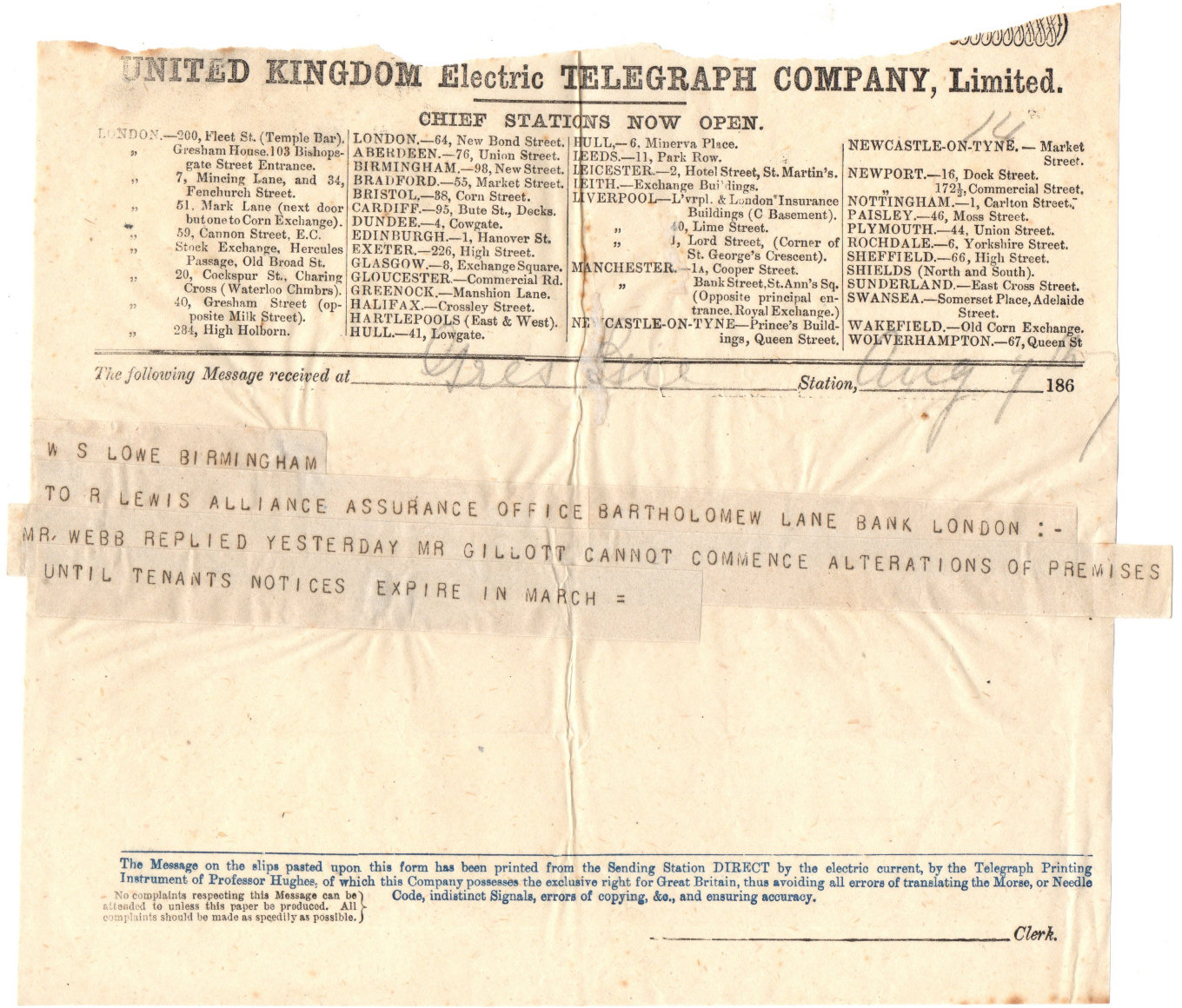
This has added at the bottom in blue :
"The message on the slips pasted upon this form has been printed from the Sending Station DIRECT by the electric current, by the Telegraph Printing Instrument of Professor Hughes, of which
this Company possesses the exclusive right for Great Britain, thus avoiding all errors of translating the Morse, or Needle Code, indistinct Signals, errors of copying, &c., and ensuring accuracy."
These machines were still in use when the Post Office took over, as noted at the beginning of their Form H2 which had instructions for their use on page 16(29).
See also the [No.52.] Memorandum form shown below.
Delivery Form listing.
| Provisional Reference | Form number | Date on form | Dates used | Size mm. | London Offices | Other UK Mainland | Printer | Comments |
|---|---|---|---|---|---|---|---|---|
| UKET-1861-1 | - | 186_ | 22/11/1861 | ???? | 1 | 0 | . | Minimal |
| UKET-2a-1864-1 | 2a | 186_ | 19/11/1864 | ???? | 6 | 16 | . | Stations now open |
| UKET-2a-1865-1 | 2a | 186_ | 25/3/1865 | 182 x 247 | 8 | 20 | . | Chief Stations now open |
| UKET-2d-1864-1 | 2d | 186_ | 27/11/1864 | ???? | 8 | 24 | . | Chief Stations now open |
| UKET-2d-1864-1 | 2d | 186_ | 17/11/186? | 185 x 244 | 8 | 24 | . | BRADFORD |
| UKET-2d-1865-1 | 2d | 186_ | 31/9/1865 | ???? | 8 | 32 | . | 'Promoters .of Uniform.. ' |
| UKET-2d-1866-1 | 2d | 186_ | 30/10/1866 | ???? | 8 | 32 | . | 'Promoters .of Cheap.. ' |
| UKET-2d-1869-1 | 2d | 186_ | 22/8/1869 | ???? | 10 | 43 | . | Chief Stations now open |
| UKET-3?-1867-1 | 3? | 186_ | 7/8/1867 | ???? | 10 | 37 | . | Chief Stations now open |
A [No.52.] form, dated 3 September 1866, with blue "SPECIMEN" sticker with what looks like the address "98A New Street". The UKET had their office at 98 New Street, Birmingham.
Memorandum of Birmingham Station. - Image courtesy of Jim Hammond. - My Ref. UKET-52-1866-1
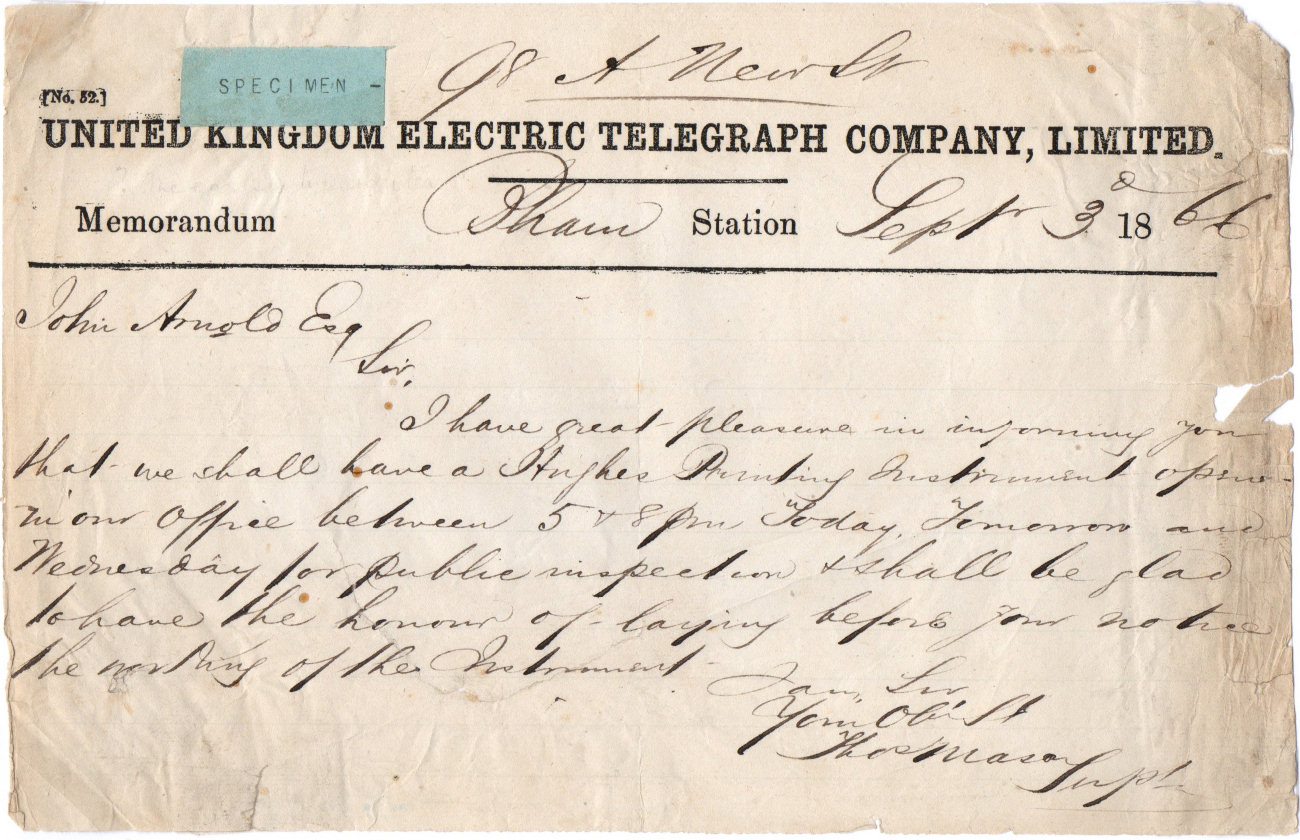
I think that the blue "SPECIMEN" indicates that this is an example telegram to be sent to a number of recipients. This is for John Arnold. The contents read :
"I have great pleasure in informing you that we shall have a Hughes Printing Instrument open in our Office between 5 & 8 pm Today, Tomorrow and Wednesday
for public inspection & shall be glad to have the honour of laying before your notice the working of the Instrument." (I think)
See the example of the use of this machine at Birmingham shown above.
Envelopes.
An envelope used for Registered delivery 2nd July 1866 (4d plate 8 & 1d plate 91), courtesy of Mark Gibson.
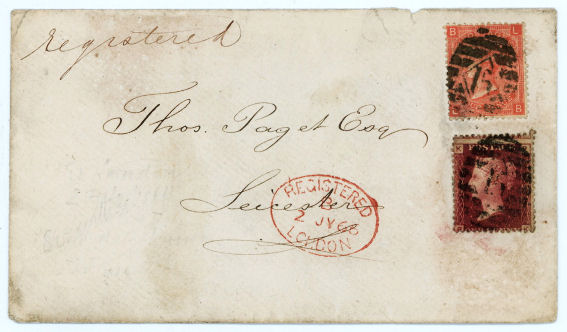
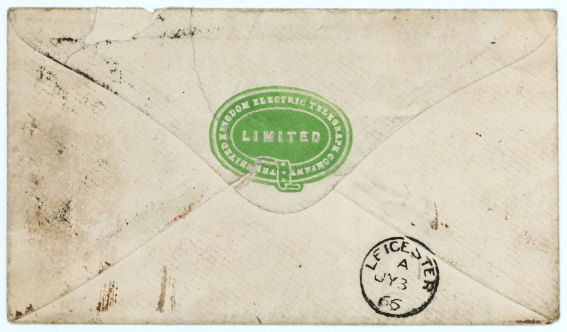
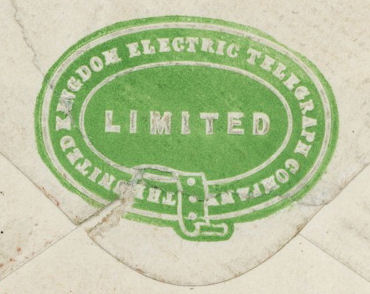
Delivery envelope dated 22nd August 1868, with handstamp (presumably the makers) of H. T. Cooke & Son, Warwick. (Henry T. Cooke) - My Reference: UKET_Env-1868-1
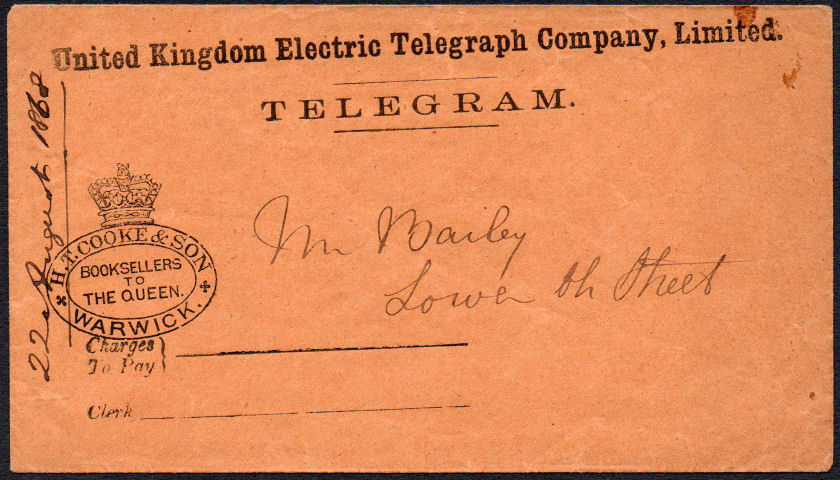
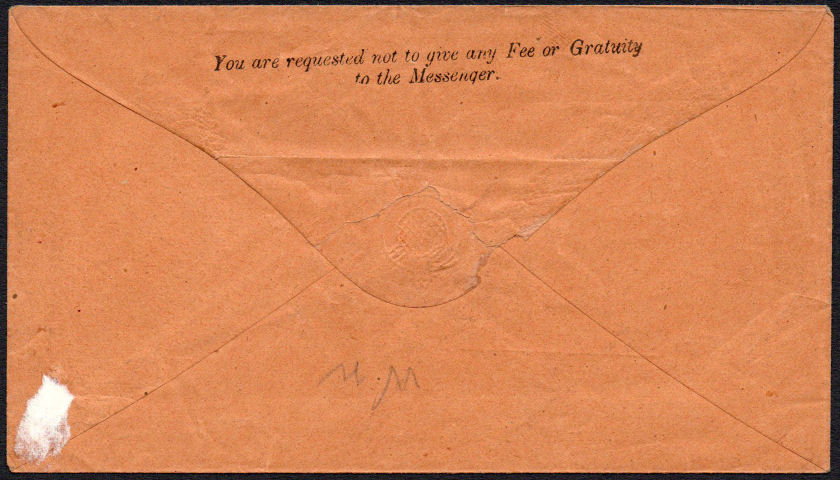
This company appears to have been on the UKET network, see the form of 1869 above. Image courtesy of Steve Lawrie.
Receipts.
Here is a Bankers Receipt for £5 as part of a letter dated 13 November 1863. It presumably was sent with a cheque. - My Reference: UKET_Rec-1863-1
"being the first payment on a Bond".
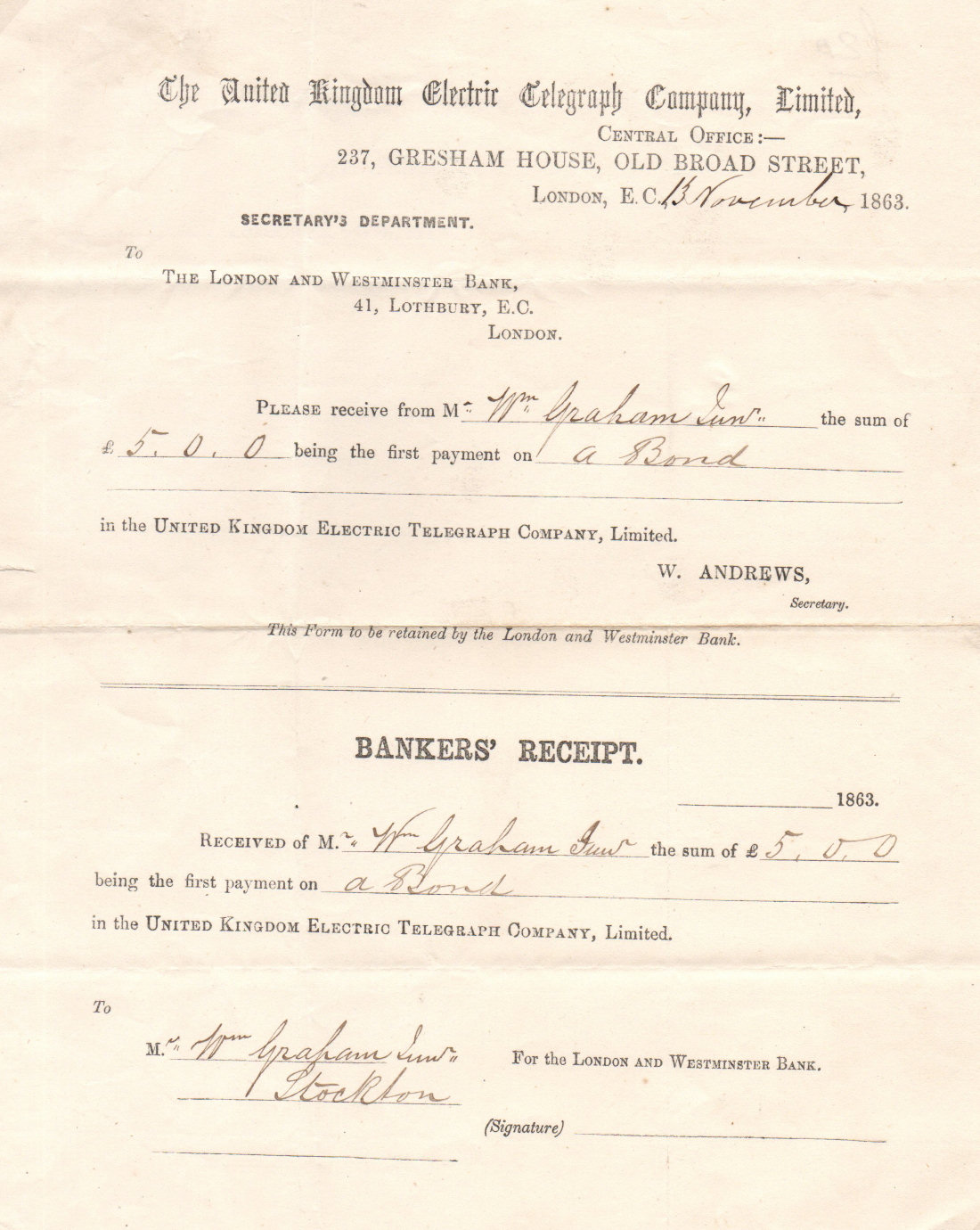
Image courtesy of Jim Hammond.
Here is a receipt for 1/6d dated 25 April 1866. It still has the 1865 slogan, - My Reference: UKET_Rec-1866-1
but perhaps is not meeting its' targets.
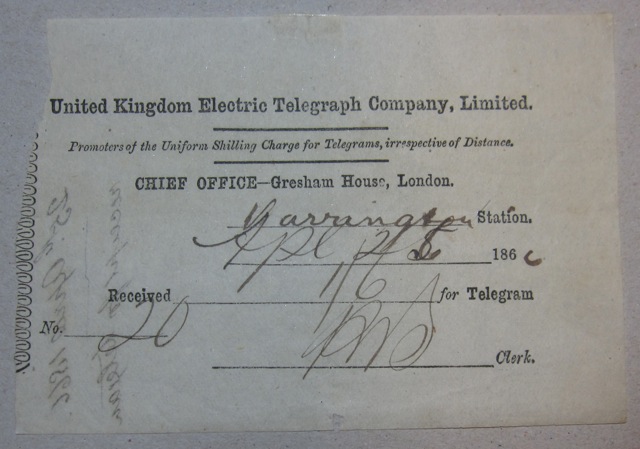
Image courtesy of Mark Gibson.
Last updated 19th. July 2023
©Copyright Steve Panting 2012/13/14/15/16/17/18/19/20/21/22/23 except where stated.
Permission is hereby granted to copy material for which the copyright is owned by myself, on condition that any data is not altered and this website is given credit.